The post iOS26 and the Future of Attribution: Is This the End of Marketing as We Know It? first appeared on B2B Website Platform Developer - Bright Vessel.
]]>Apple has been positioning itself as the privacy champion for years now. But with iOS 26, they're taking it to a whole new level, and it's about to shake the foundation of how we measure digital marketing. We're not talking about another cookie banner or permission prompt here. Apple's going after something much more fundamental: the URL tracking parameters that have been the backbone of campaign measurement for decades.
Think about it. For years, marketers have lived and breathed UTMs, gclids, fbclids, and all those other tracking strings appended to URLs. These brief snippets of text have enabled us to track a customer's journey, calculate ROI, and demonstrate that our campaigns are effective. IOS 26 automatically strips them out in Apple Mail, Messages, and Safari Private Browsing. Even more concerning? Apple also allows users to extend this protection to their regular browsing.
What this means for marketers is that attribution as we know it might be on life support. The rules are changing rapidly, and brands that don't adapt quickly could operate in the dark.
The State of Attribution Before iOS 26
Before we dive into what iOS 26 breaks, let's discuss how attribution actually worked, as that world is disappearing rapidly.
For the better part of two decades, digital marketing attribution has relied on a few key pieces:
UTMs (Urchin Tracking Module codes): These date back to the early days of Google Analytics. They are simple text strings attached to URLs that let you tag campaigns by source, medium, and content. They are basic but effective.
Platform-specific identifiers like gclid and fbclid acted as unique click IDs, creating a direct link between someone seeing your ad and taking action on your website.
Attribution models: Whether you preferred first-click, last-click, or Google's data-driven attribution, these tools helped assign credit for conversions across different touchpoints.
Was this system perfect? Not even close. However, it gave marketers a workable framework for connecting ad spend to results. Without these mechanisms, running campaigns would feel like throwing darts blindfolded.
What iOS 26 Actually Changes
With iOS 26, Apple's making those tracking strings vanish in several key environments:
1. Apple Mail and Messages: Links shared or clicked through these apps will automatically strip standard tracking parameters. If you're running email campaigns or relying on social shares, you'll lose significant attribution visibility, especially for those crucial email-to-website conversion sequences.
2. Safari Private Browsing: Private browsing was already a black box for cookies, but now it's erasing URL parameters too. Early beta testers have reported that gclids disappear consistently, completely cutting off Google Ads' ability to track conversions.
3. Optional Safari Setting for Regular Browsing: This is the big one. Apple isn't stopping with private session; they're giving users a toggle in iOS 26 that strips tracking parameters during everyday browsing. If this setting becomes widely adopted, we could see attribution breakdowns shift from an edge case to a mainstream crisis.
4. Inconsistencies in Beta Testing: Here's where it gets messy. Developers testing early versions have noticed some unpredictable behavior:
- Sometimes gclids vanish instantly, even outside Private Browsing
- Sometimes UTMs stick around in places where they shouldn't
- Different behaviors depending on app version or Safari build
This unpredictability is almost as bad as a clean break. At least with a consistent rule, you can plan around it. But when the behavior changes based on factors you can't control? That makes preparation nearly impossible.
Technical Breakdown: How URL Stripping Actually Works
Let me break down the mechanics so you understand the scope of this change.
Query String Parameters: Those "?utm_source=google&utm_medium=cpc" bits tagged onto URLs. Your web server ignores them for page rendering, but analytics platforms capture them to assign campaign credit.
Automatic Sanitization: Apple's system identifies known tracking parameters, UTMs, gclids, fbclids, and other standard vendor-specific identifiers and removes them before the URL request is processed.
Edge Case Behavior: Some beta testers found that only specific identifiers, such as gclids, were consistently stripped, while UTMs occasionally made it through. This suggests Apple might still be testing different approaches before the full rollout.
Impact on Redirect Chains: Many ad platforms use redirects to pass identifiers between domains. When those parameters go missing, the entire attribution chain breaks, leaving you with incomplete or completely lost data in your analytics.
The result? Campaigns lose visibility. Instead of seeing that a conversion came from your Google Ads campaign or Facebook retargeting, your analytics might show "Direct Traffic" or "Organic." Good luck optimizing campaigns when you can't tell what's actually working.
Apple's Real Motivation and Why Server-Side Tracking Wins
Apple's Motivation: Privacy Champion or Market Strategist?
On the surface, Apple frames iOS 26 as another step forward in protecting user privacy. Their message resonates: people should browse, shop, and communicate without every click being tracked, packaged, and sold. In a world full of data breaches and surveillance fatigue, that's a compelling narrative.
But here's what is really happening. Apple has been systematically building its own advertising ecosystem, with Apple Search Ads being the most visible component. By dismantling measurement capabilities for competitors Google, Meta, and the entire third-party ad tech industry, Apple makes its own channels look more reliable simply because they operate inside its controlled environment.
This isn't their first rodeo. Remember Intelligent Tracking Prevention in Safari? Or those App Tracking Transparency prompts that decimated Facebook's targeting? Each move has made outside ad platforms less effective while leaving Apple's ecosystem untouched.
The Real Impact on Marketers and Advertisers
The fallout from iOS 26 could be massive for brands that depend on precise attribution to justify their ad spend. Here's what we're looking at:
Loss of Click-Level Data: Without UTMs or gclids, you can't trace traffic back to specific campaigns or individual ads. This breaks everything from A/B testing to budget allocation decisions.
Distorted Analytics: Get ready to see huge spikes in "Direct" and "Organic" traffic in your dashboards. Campaigns that actually drive conversions will appear less effective than they really are.
Reduced Ad Relevance: Attribution isn't just about proving ROI; it feeds the optimization loops. Platforms like Google Ads utilize conversion data to refine targeting and bidding strategies. Cut off that feedback, and the ads users see become less relevant over time.
Budget Inefficiency: When attribution becomes unclear, brands often either overspend (hoping to brute-force results) or underspend (fearing wasted dollars). Both scenarios hurt growth.
Fragmented Reporting: Teams that once relied on a unified analytics platform now need to juggle multiple data sources, CRM systems, ad platform reporting, and server logs to understand what's happening.
Attribution isn't dying, but it's becoming fragmented, messy, and a lot less trustworthy.
Server-Side Tracking: The Solution We've Been Using for Years
For years, server-side tracking was that thing everyone talked about as "the future of attribution." Well, iOS 26 has just been released, and we saw this coming.
What Is Server-Side Tracking?
Instead of relying on someone's browser to collect and pass data, server-side tracking moves that responsibility to your server or a trusted endpoint. Here's how it works:
- A user clicks your ad, triggering a request to your server
- Your server enriches the event with the necessary parameters
- That event gets passed securely to ad platforms like Google Ads, Meta, or LinkedIn
This approach sidesteps most client-side limitations, including URL parameter stripping, cookie blocking, and browser privacy filters.
Why We Know It Actually Works
We didn't wait for Apple to force our hand. At Bright Vessel, we implemented server-side tracking almost three years ago, rolling it out across 53 education websites. The results were impossible to ignore: higher match rates, cleaner attribution, and smarter bidding signals that translated into lower CPAs for our clients.
The proof is public. In our Endeavor Schools case study, lead generation scaled from 12 to over 100 schools, delivered over 100,000 qualified leads, reduced CPAs to around $10, and drove over 1,000% growth in SEO traffic. That kind of scale wouldn't have been possible if we'd stuck with browser-only tracking.
We also documented exactly how we did it in two detailed resources:
- Step-by-Step Tutorial: Building Rock Solid Server-Side Tracking
- Server-Side Tracking Setup Breakdown
These aren't theoretical think pieces; they're working playbooks that emerged from real production deployments.
The Advantages of Server-Side Tracking
Greater Control: You define what data gets collected and ensure compliance with privacy regulations.
Resilience: Data flows stay intact even when browsers or apps try to block client-side tracking.
Accuracy: Server logs capture more consistent information than client-side scripts, which often get disrupted by ad blockers or unstable connections.
The Challenges We Solved Early
Cost and Complexity: We developed repeatable processes that made scaling across dozens of sites feasible without incurring significant costs.
Data Governance: Our setups enforced proper consent collection and logging from day one.
Integration: We developed workflows that enabled ad platforms to recognize and utilize server-side events correctly.
So when iOS 26 starts stripping parameters by default, our clients aren't panicking. They already have a stronger, more resilient attribution system running.
Offline Conversion Modeling with CRM Data
Even with server-side tracking, some gaps remain. That's where offline conversion modeling comes in, connecting marketing activity to revenue events that happen outside the browser.
How It Actually Works
- A prospect clicks your ad, fills out a form, books a call, or downloads a resource.
- That lead gets tracked in your CRM and moves through the sales process
- Weeks or months later, the lead converts into actual revenue
- Your CRM pushes that closed revenue event back to the ad platform
Why This Matters in the iOS 26 Era
Closing the Attribution Gap: Even if click-level parameters are stripped, your campaigns still get proper credit.
Aligns with Real Revenue: ROI calculations tie to actual deals closed, not just vanity clicks.
Feeds Smarter Algorithms: Platforms like Google Ads use offline conversion imports to optimize for higher-value leads, rather than focusing solely on any conversion.
We've seen this approach work incredibly well in the education sector. By linking CRM outcomes back to ad platforms, we provided algorithms with the necessary feedback to favor campaigns that drove actual enrollment, not just website visits.
First-Party Data, Real Results, and What Comes Next
First-Party Data as Your Foundation
Server-side tracking and offline conversion modeling are tactical fixes. The real strategic foundation is first-party data. Third-party identifiers are vanishing rapidly, and platforms that once provided marketers with endless user-level data are now locking those gates.
First-party data is everything you collect directly from your audience: email signups, purchase histories, loyalty program participation, survey responses, and even offline interactions logged in your CRM. Unlike borrowed data, it's durable because it's built on explicit consent and direct relationships.
At Bright Vessel, we saw this shift when we started building server-side systems across those 53 education websites. Our biggest lesson? The tracking setup only works if you have clean first-party data flowing through it. This meant helping clients build stronger opt-in funnels, collect accurate information at every touchpoint, and tie everything back to CRM records.
The result was attribution that survived privacy rollouts. While competitors were losing visibility in their analytics, our clients could still connect campaigns to real enrollments and revenue.
Case Studies That Actually Prove the Point
Endeavor Schools: From 12 to 100+ Locations
Our Endeavor Schools case study tells the whole story. When we took over, they had 12 schools. With server-side tracking, CRM integration, and a strong focus on first-party data capture, they expanded to over 100 locations. Along the way, they generated over 100,000 qualified leads, reduced CPAs to around $10, and saw SEO traffic increase by more than 1,000%.
This wasn't luck or guesswork. It was the direct result of feeding accurate, first-party enriched data back into ad platforms, allowing them to optimize campaigns around actual enrollments rather than just form fills.
Education Sector Rollout: 53 Sites and Counting
The Endeavor success wasn't a one-off. We rolled out the same model to 53 education sites in total. By standardizing the server-side architecture and layering offline conversions into ad platforms, we gave schools the kind of attribution stability that most industries still struggle to achieve.
That body of work also gave us the confidence to share our process publicly in those two resources I mentioned:
- Step-by-Step Tutorial: Building Rock Solid Server-Side Tracking
- Server-Side Tracking Setup Breakdown
These aren't shallow thought pieces; they're detailed working playbooks that emerged from real production deployments.
What I Think Happens Next: Predictions for Attribution Beyond 2025
The iOS 26 release isn't a one-off disruption. It's another step in a long trend toward a privacy-first internet. Looking ahead, here's what I expect:
Server-Side Becomes Standard Practice: By 2026, every serious brand will have some kind of server-side setup. Platforms and CMS vendors will start offering turnkey solutions because market demand will force them to.
Offline Conversion Modeling Goes Mainstream: Feeding CRM and sales data back into ad platforms will become a table-stakes requirement. Campaigns will get judged on revenue impact rather than click-through rates.
Statistical Modeling Replaces Perfect Tracking: Deterministic click-level attribution will become rare. Statistical models and platform-driven attribution will fill most gaps.
Walled Gardens Get Even Stronger: Apple, Google, and Amazon will tighten control over their ecosystems, leaving independent measurement tools less room to operate.
Agencies With Proof Will Win: Agencies pointing to real case studies, hands-on tutorials, and measurable client outcomes will stand out. Those still writing generic "how-to" content will fade into irrelevance.
Practical Steps You Can Take Right Now
For brands that want to get ahead of iOS 26 instead of reacting to it:
- Audit Your Current Tracking: Identify where UTMs and gclids are mission-critical to your measurement and start building contingency plans.
- Implement Server-Side Tracking: Don't wait for the crisis. Build or buy a solution that extracts your most essential data from the browser.
- Integrate Your CRM: Ensure that lead and revenue data flow back into your ad platforms for improved optimization.
- Invest in First-Party Data: Strengthen your opt-in processes and build more direct relationships with your audience.
- Educate Your Stakeholders: Make sure leadership understands that attribution won't look the same going forward, but it can still be accurate and valuable.
Conclusion: The End of Lazy Attribution
Will iOS 26 finally end attribution once and for all? Not a chance. What it will kill is lazy attribution. The days of simply attaching UTMs to a URL and calling it a measurement strategy are officially over.
At Bright Vessel, we learned this lesson early. By rolling server-side tracking across 53 education sites, tying CRM data back into platforms, and focusing relentlessly on first-party capture, we proved that attribution can survive and thrive in a privacy-centric world.
Apple may be stripping parameters from URLs, but attribution isn't dead. It's evolving into something more sophisticated, accurate, and aligned with tangible business outcomes. The only question is whether your brand will grow with it or get left behind.
You make the choice. Based on what we've seen work in the real world, I recommend making it soon.
The post iOS26 and the Future of Attribution: Is This the End of Marketing as We Know It? first appeared on B2B Website Platform Developer - Bright Vessel.
]]>The post Advanced eCommerce Email Strategy for WooCommerce Stores first appeared on B2B Website Platform Developer - Bright Vessel.
]]>Success in eCommerce email marketing depends on mastering automation workflows, implementing proper segmentation logic, and understanding the technical infrastructure that ensures your messages reach inboxes rather than spam folders. We'll explore advanced personalization techniques, mobile optimization challenges, and the specific technical considerations that separate professional email operations from amateur efforts.

This chart visualizes the relative strategic focus required across key components of a modern WooCommerce email marketing system. Deliverability and automation demand deeper technical investment, while personalization and mobile optimization play vital but supportive roles in driving performance.
The Technical Foundation of Modern Email Marketing
Email marketing's continued importance stems from several factors differentiating it from other digital channels. Unlike paid advertising platforms, where costs fluctuate and algorithm changes affect reach, email provides direct communication channels businesses own and control. However, this control comes with significant technical responsibilities.
Technical Reality Check: Email deliverability depends on SPF, DKIM, and DMARC authentication protocols. Even well-crafted campaigns can end up in spam folders without proper DNS configuration. Most store owners overlook these fundamental requirements, focusing instead on design and copy while their technical foundation crumbles.
The shift from third-party cookies has increased email's strategic value, but only for businesses that understand the underlying mechanics. Studies suggest strong ROI potential for email marketing, with some industry reports indicating returns of $30-40 per dollar spent, though these figures vary significantly based on implementation quality and industry vertical.
Why email remains strategically important:
- Direct communication channel independent of platform algorithm changes
- Measurable performance through detailed analytics and conversion tracking
- Scalable personalization through behavioral data integration
- Automated workflow capabilities that operate without constant management
- Revenue recovery opportunities through cart abandonment and re-engagement sequences
- Customer lifecycle management from acquisition through retention
Advanced List Management and Segmentation Strategies
Effective email marketing begins with sophisticated list management beyond basic demographic segmentation. Professional email operations require understanding subscriber lifecycle stages, engagement patterns, and behavioral triggers that indicate purchase intent or churn risk.
Implementation Challenge: Most WooCommerce stores struggle with data integration between their email platform and customer database. Proper segmentation requires real-time data syncing, custom field mapping, and automated tagging based on purchase behavior, browsing patterns, and engagement metrics.
List hygiene involves more than removing inactive subscribers. Professional operations monitor engagement decay patterns, implement sunset sequences for disengaged users, and use suppression lists to prevent deliverability damage. The technical challenge lies in balancing list size with engagement quality while maintaining sender reputation.
Advanced Segmentation Strategies:
- Behavioral Segmentation: Track browsing patterns, abandoned cart sequences, and product category preferences
- Lifecycle Stage Mapping: Identify prospects, first-time buyers, repeat customers, and at-risk accounts
- Engagement Velocity: Segment based on email interaction frequency and recency
- Purchase Pattern Analysis: Identify seasonal buyers, bulk purchasers, and impulse shoppers
- Geographic and Timezone Optimization: Deliver messages based on local relevance and optimal send times
- Device and Channel Preferences: Tailor content format based on how subscribers typically engage
Content Strategy and Conversion Optimization
Effective email content requires understanding cognitive load principles, visual hierarchy, and the constraints of email rendering across different clients. The technical challenge involves creating responsive designs that maintain visual integrity across Outlook, Gmail, Apple Mail, and mobile clients with varying CSS support.
Content Performance Factors: Subject line performance varies significantly by industry, audience, and send frequency. Testing should focus on specific elements: character count, emotional triggers, personalization tokens, and urgency indicators. However, what works for one audience segment may fail for another.
Professional email content strategies balance promotional messaging with educational value, avoiding the appearance of pure sales pitches that trigger spam filters and subscriber fatigue. The technical implementation requires understanding how content filters evaluate message content, image-to-text ratios, and sender reputation factors.
Technical Content Optimization:
- Subject line optimization considering character limits across email clients
- Preview text implementation that complements rather than repeats subject lines
- HTML coding practices that ensure consistent rendering across email clients
- Image optimization balancing visual impact with load speed
- Call-to-action design with sufficient contrast ratios and touch target sizes
- Content hierarchy that guides readers through complex information efficiently
Automation Architecture and Workflow Design
Email automation represents the most technically complex aspect of professional email marketing. Effective automation requires understanding trigger logic, conditional branching, and data integration patterns that respond to real-time customer behavior across multiple touchpoints.
Automation Complexity: Professional automation workflows involve multiple decision points, time delays, and conditional logic that can become increasingly complex. Common failure points include trigger timing conflicts, data sync delays, and improper exception handling when customer data changes mid-workflow.
The technical challenge lies in creating workflows that feel personal and timely while operating autonomously. This requires sophisticated data integration, proper error handling, and continuous monitoring to ensure workflows perform as intended when customer behavior deviates from expected patterns.
Important Automation Workflows:
- Welcome Series Architecture: Multi-step onboarding sequences with conditional branching based on engagement
- Cart Recovery Logic: Time-sensitive sequences with escalating incentives and inventory awareness
- Post-Purchase Flows: Delivery confirmations, usage guidance, and cross-sell opportunities
- Re-engagement Sequences: Graduated approaches to win back inactive subscribers before suppression
- Lifecycle Milestone Triggers: Anniversary, birthday, and custom event-based communications
- Win-Back Campaigns: Targeted approaches for customers with extended purchase gaps
Advanced Personalization Beyond Basic Tokens
Modern email personalization extends far beyond inserting first names into subject lines. Professional implementation requires dynamic content generation based on behavioral data, predictive analytics, and real-time inventory information integrated with customer browsing and purchase history.
The technical challenge involves creating personalization systems that scale across thousands of subscribers while maintaining relevance and avoiding the uncanny valley effect, where personalization feels invasive rather than helpful. This requires sophisticated data integration and content management systems.
Personalization Implementation: True personalization requires robust data integration between your WooCommerce store, email platform, and potentially external data sources. The technical complexity increases exponentially when attempting real-time personalization based on current inventory, browsing behavior, and predictive analytics.
Advanced Personalization Techniques:
- Dynamic product recommendations based on collaborative filtering algorithms
- Behavioral trigger integration with real-time browsing data
- Location-based content adaptation for shipping, weather, and local events
- Purchase history analysis for cross-sell and upsell opportunities
- Seasonal preference learning based on historical engagement patterns
- Content format preferences based on device usage and engagement patterns
Mobile Optimization and Technical Considerations
According to industry reports, over 70% of eCommerce emails are opened on mobile devices, creating significant technical challenges for email design and functionality. Mobile optimization requires understanding responsive design principles, touch interface design, and the specific limitations of mobile email clients.
Mobile Technical Challenges: Mobile email rendering involves complex CSS limitations, varying screen sizes, and touch interaction requirements. The technical challenge extends beyond responsive design to include load speed optimization, image compression, and ensuring functionality across different mobile email clients with varying capabilities.
Professional mobile email optimization requires testing across multiple devices, email clients, and network conditions. The technical implementation involves progressive enhancement strategies that ensure functionality even when advanced features fail to load correctly.
Mobile Optimization Requirements:
- Single-column layouts that adapt gracefully across screen sizes
- Touch-friendly button sizing with a minimum 44px touch targets
- Optimized image compression, balancing quality with load speed
- Simplified navigation that works with thumb-based interaction
- Progressive enhancement for varying email client capabilities
- Load speed optimization for slower mobile connections
- Readable typography without requiring zoom functionality
- Strategic white space usage for improved mobile readability
- Cross-client testing across iOS Mail, Gmail app, and Outlook mobile
- Fallback strategies for unsupported CSS features
Testing Methodologies and Statistical Significance
Professional email testing requires understanding statistical significance, sample size calculations, and proper experimental design. Many businesses run tests without sufficient sample sizes or control groups, leading to false conclusions about campaign performance.
Testing Implementation Challenges: Proper A/B testing requires understanding statistical significance, sample size requirements, and testing duration. Many email tests fail because they lack sufficient sample sizes, run for inadequate time periods, or test too many variables simultaneously, making results unreliable.
Effective testing strategies balance the desire for quick results with the need for statistically valid conclusions. This requires planning test duration, allocating sample size, and ensuring external factors don't contaminate results.
Professional Testing Approaches:
- Subject line testing with proper sample size calculations
- Send time optimization based on subscriber behavior patterns
- Content format testing across different subscriber segments
- Call-to-action optimization, including placement, color, and wording
- Personalization effectiveness measurement across different approaches
- Email frequency optimization, balancing engagement with unsubscribe rates
Advanced Analytics and Performance Measurement
Professional email marketing measurement extends beyond basic open and click rates, including attribution analysis, customer lifetime value impact, and cross-channel performance integration. The technical challenge involves integrating email performance data with broader business metrics.
Sophisticated measurement strategies require understanding the limitations of email tracking, particularly with iOS privacy changes affecting open rate accuracy, and implementing alternative measurement approaches that provide more reliable insights into actual business impact.
Measurement Evolution: iOS Mail Privacy Protection has significantly impacted open rate tracking accuracy. Professional email marketers now focus more heavily on click-through rates, conversion tracking, and business outcome measurement rather than relying on potentially inflated open rate metrics.
Advanced Performance Metrics:
- Click-Through Rate Analysis: Segment-specific engagement measurement and trend analysis
- Conversion Attribution: Multi-touch attribution connecting email interactions to revenue
- Customer Lifetime Value Impact: Long-term revenue effects of email engagement
- List Health Metrics: Engagement decay patterns and deliverability indicators
- Unsubscribe Pattern Analysis: Understanding churn triggers and prevention opportunities
- Cross-Channel Performance: Email's role in broader customer journey optimization
Technical Infrastructure and Deliverability Management
Professional email marketing requires a robust technical infrastructure, including proper DNS configuration, authentication protocols, and sender reputation management. Many businesses focus on content and design while neglecting the technical foundation that determines whether emails reach inboxes.
Deliverability Technical Requirements: Email deliverability depends on SPF, DKIM, and DMARC authentication, dedicated IP warming procedures, and consistent sending patterns. Technical configuration errors can result in legitimate emails being filtered as spam, regardless of content quality.
The technical challenge involves maintaining sender reputation while scaling email volume, managing bounce handling procedures, and implementing proper list hygiene practices that prevent deliverability degradation over time.
Infrastructure Requirements:
- SPF, DKIM, and DMARC authentication protocol implementation
- Dedicated IP warming and reputation management procedures
- Bounce handling automation and suppression list maintenance
- Complaint feedback loop monitoring and response procedures
- Send frequency optimization to maintain consistent engagement patterns
- Technical monitoring for delivery failures and authentication issues
WooCommerce Integration and Plugin Considerations
Selecting appropriate email marketing tools for WooCommerce requires understanding technical integration requirements, data synchronization capabilities, and scalability limitations. The technical challenge involves balancing functionality with performance impact on your store.
Professional implementations require evaluating plugins based on their data integration capabilities, automation sophistication, and ability to handle complex segmentation without negatively impacting site performance.
Key Plugin Evaluation Criteria:
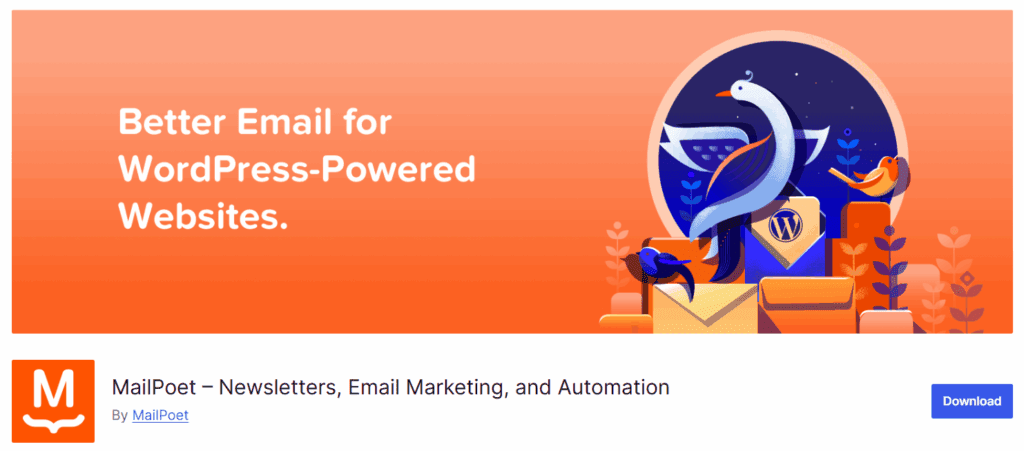
MailPoet
WordPress-native solution with direct WooCommerce integration, suitable for businesses prioritizing data control and GDPR compliance.
- Direct WordPress database integration
- Built-in automation workflows
- GDPR compliance features
- Performance impact on WordPress hosting
- Limited advanced segmentation capabilities
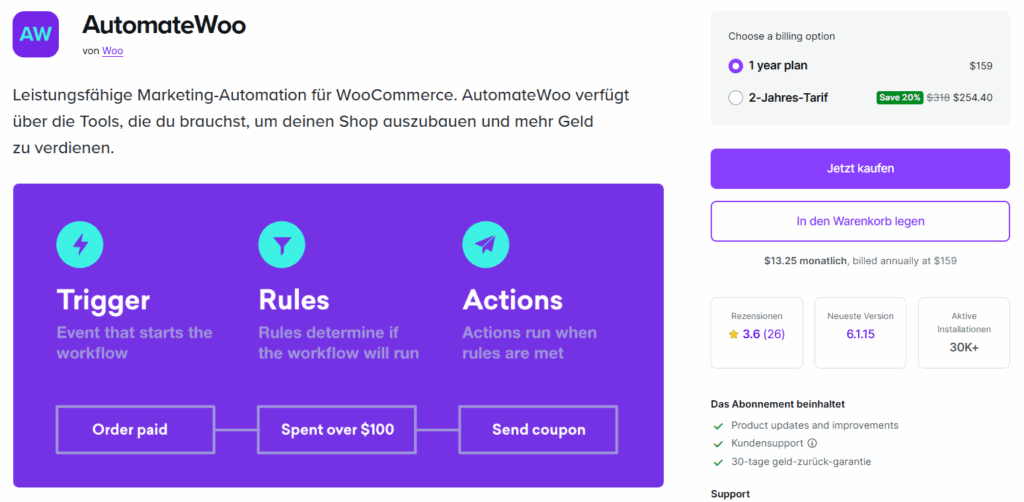
AutomateWoo
Advanced automation platform with sophisticated trigger logic and workflow customization capabilities.
- Complex automation workflow builder
- Advanced WooCommerce data integration
- Custom trigger and condition logic
- SMS integration capabilities
- Requires technical expertise for advanced features
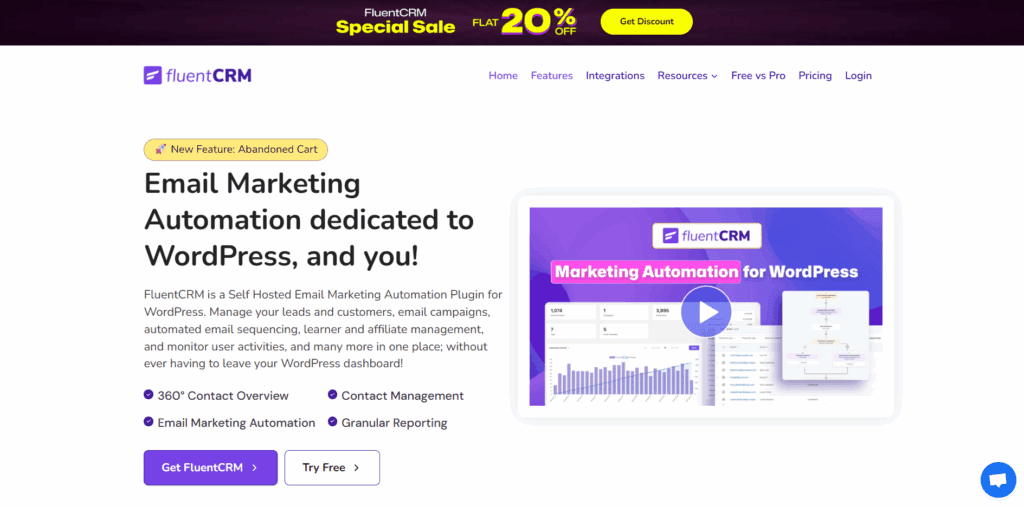
FluentCRM
Self-hosted CRM solution with email marketing automation designed for WordPress integration.
- Complete customer relationship management
- Advanced segmentation and tagging
- Visual automation builder
- Data ownership and privacy control
- Learning curve for comprehensive utilization

Omnisend
Omnisend is an eCommerce-focused platform with powerful omnichannel automation.
- Cart recovery workflows
- Pre-built templates and automations
- SMS and email marketing support
- Integration with WooCommerce products
- Visual drag-and-drop builder
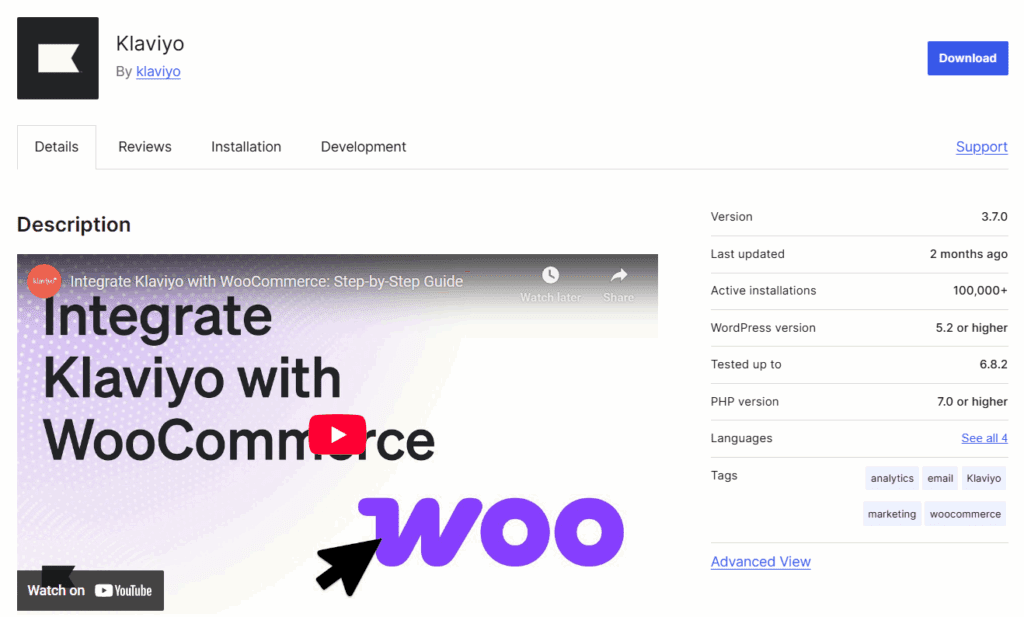
Klaviyo
Klaviyo offers robust automation and segmentation tools that align with WooCommerce.
- Syncs with purchase data
- Real-time triggers and flows
- Smart audience segmentation
- Predictive analytics
- Multi-channel (email & SMS) campaigns
Professional Implementation Strategies
Implementing professional-grade email marketing requires systematic approaches that address technical requirements, strategic planning, and ongoing optimization processes. The challenge lies in balancing immediate needs with long-term scalability requirements.
Many businesses attempt to implement advanced email marketing without an adequate technical foundation, leading to deliverability issues, poor user experience, and ultimately disappointing results. Professional implementation requires understanding the technical infrastructure and strategic elements necessary for sustained success.
Implementation Reality: Professional email marketing implementation often requires 3-6 months to reach optimal performance. This includes technical setup, automation workflow development, segmentation refinement, and iterative testing to optimize performance across subscriber segments.
Strategic Implementation Best Practices:
- Deliverability infrastructure setup before content creation
- Systematic testing of technical integration across all email clients
- Gradual increase in automation complexity to prevent technical failures
- Comprehensive analytics implementation for performance measurement
- Regular technical audits to avoid performance degradation
- Scalable processes that maintain quality as volume increases
- Documentation of technical configurations and workflow logic
- Team training on technical requirements and optimization strategies
- Continuous monitoring of deliverability metrics and sender reputation
- Integration planning for future business growth and complexity requirements
Advanced Support and Professional Services
Complex email marketing implementations often require specialized expertise beyond basic campaign creation. Professional email marketing involves technical challenges in areas like deliverability optimization, advanced automation logic, and cross-platform integration that many businesses lack the internal resources to address effectively.
When evaluating professional email marketing services, consider technical expertise in authentication protocol configuration, advanced segmentation logic, and automation workflow architecture. These technical foundations often determine success more than creative elements or basic campaign management.
Professional Service Considerations: Email marketing agencies vary significantly in technical expertise. Look for providers who demonstrate understanding of deliverability mechanics, automation logic design, and advanced analytics implementation rather than focusing primarily on creative design or basic campaign management.
Professional email marketing services should provide technical infrastructure assessment, advanced automation implementation, and ongoing optimization based on detailed performance analytics rather than surface-level metrics.
Professional Service Elements:
- Technical infrastructure audit and optimization recommendations
- Advanced automation workflow design with conditional logic implementation
- Deliverability optimization, including authentication and reputation management
- Sophisticated segmentation strategy based on behavioral and transactional data
- Cross-platform integration with existing business systems and processes
- Comprehensive analytics implementation with business outcome measurement
Building Sustainable Email Marketing Systems
Effective eCommerce email marketing requires balancing technical expertise with strategic planning to create systems that scale efficiently while maintaining personal relevance for subscribers. The technical challenges involved in professional email marketing often exceed what most businesses can effectively manage internally without dedicated expertise.
Success depends on understanding the technical infrastructure requirements, implementing sophisticated automation logic, and continuously optimizing based on detailed performance analytics. These elements create email marketing systems that drive sustainable business growth rather than short-term promotional results.
For businesses serious about implementing professional-grade email marketing systems, working with experienced technical specialists can provide the expertise necessary to navigate complex implementation challenges and achieve optimal results. Investing in proper technical foundation and strategic implementation typically pays dividends through improved performance, better customer relationships, and sustainable revenue growth.
The post Advanced eCommerce Email Strategy for WooCommerce Stores first appeared on B2B Website Platform Developer - Bright Vessel.
]]>The post How to Export Top Performing Google Ads Search Terms to Google Sheets Using Apps Script first appeared on B2B Website Platform Developer - Bright Vessel.
]]>Our script, "How to Export Top-Performing Google Ads Search Terms to Google Sheets Using Apps Script," is perfect for agencies managing multiple clients or marketers who want to stop guessing.
Let’s break it down.
What Export Top Performing Google Ads Search Terms Script Does
- Pulls 6 months of query data across all campaigns
- Filters out garbage: branded terms and low-converting noise
- Calculates cost per conversion and conversion rate
- Drops everything into a clean Google Sheet, one tab per account
How to Add a Google Ads Script
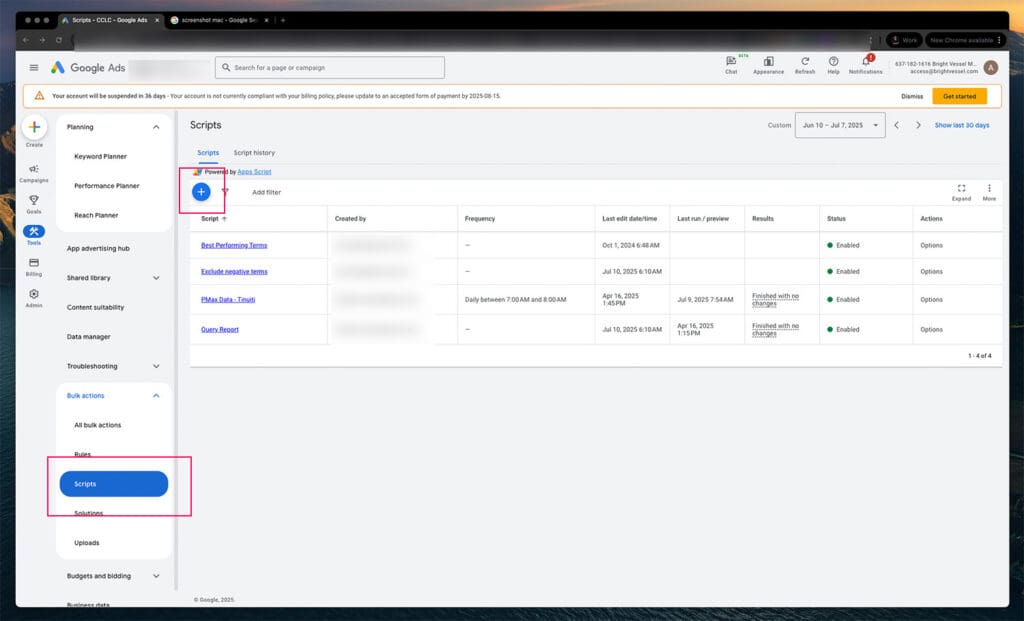
The Scripts section is where all bulk automation is set up within Google Ads MCC.
1. Log in to your MCC (Manager Account) and go to Tools > Bulk Actions > Scripts
2. Click the blue plus (+) button to create a new script
This opens the script editor. Don’t worry, you won’t be coding from scratch. You’ll be pasting a script that’s already written. Clicking this button creates a blank script container for your automation.
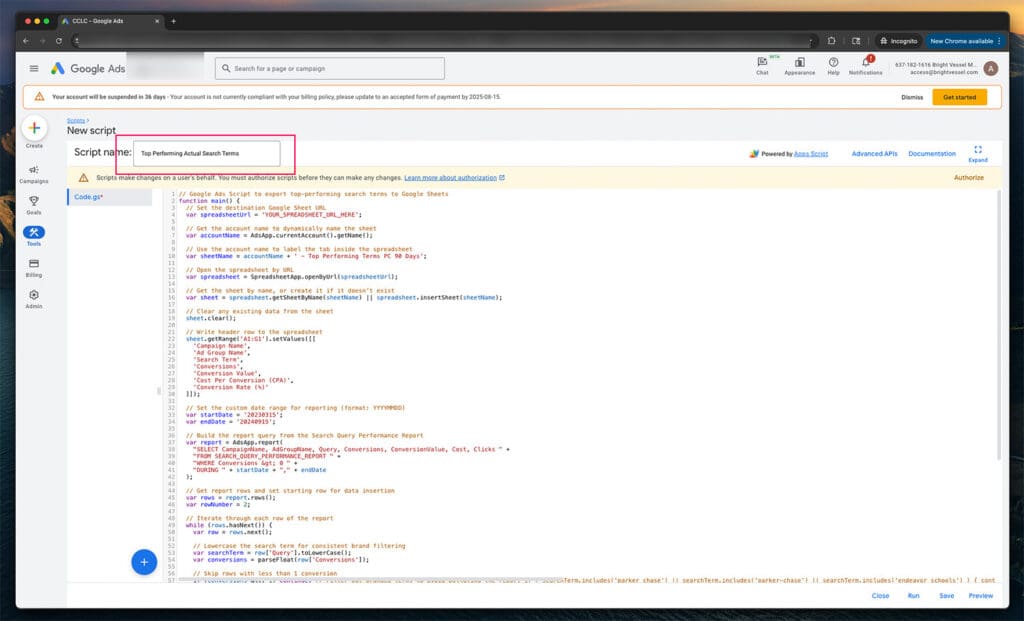
Naming your script is essential for long-term management and scheduling.
3. Name the script so it’s easy to identify later
At the top of the script editor window, you’ll see a field to enter a name. Use something clear like “Top Performing Search Terms Report.” This will help you recognize the script later when managing multiple scripts or accounts.
You can name it Top Performing Actual Search Terms and drop in the script (included at the bottom of this post).

Name the script
4. Paste the entire script into the editor
function main() {
// Set the destination Google Sheet URL
var spreadsheetUrl = 'Paste Your Google Sheet URL Here';
// Get the account name to dynamically name the sheet
var accountName = AdsApp.currentAccount().getName();
// Use the account name to label the tab inside the spreadsheet
var sheetName = accountName + ' - Top Performing Terms PC 90 Days';
// Open the spreadsheet by URL
var spreadsheet = SpreadsheetApp.openByUrl(spreadsheetUrl);
// Get the sheet by name, or create it if it doesn't exist
var sheet = spreadsheet.getSheetByName(sheetName) || spreadsheet.insertSheet(sheetName);
// Clear any existing data from the sheet
sheet.clear();
// Write header row to the spreadsheet
sheet.getRange('A1').setValue('Campaign Name');
sheet.getRange('B1').setValue('Ad Group Name');
sheet.getRange('C1').setValue('Search Term');
sheet.getRange('D1').setValue('Conversions');
sheet.getRange('E1').setValue('Conversion Value');
sheet.getRange('F1').setValue('Cost Per Conversion (CPA)');
sheet.getRange('G1').setValue('Conversion Rate (%)');
// Set the custom date range for reporting (format: YYYYMMDD)
var startDate = '20230315';
var endDate = '20240915';
// Build the query from the Search Query Performance Report
var report = AdsApp.report(
"SELECT CampaignName, AdGroupName, Query, Conversions, ConversionValue, Cost, Clicks " +
"FROM SEARCH_QUERY_PERFORMANCE_REPORT " +
"WHERE Conversions > 0 " +
"DURING " + startDate + "," + endDate
);
// Get report rows and set starting row for data insertion
var rows = report.rows();
var rowNumber = 2;
// Iterate through each row of the report
while (rows.hasNext()) {
var row = rows.next();
// Lowercase the search term for consistent brand filtering
var searchTerm = row['Query'].toLowerCase();
var conversions = parseFloat(row['Conversions']);
// Skip rows with less than 1 conversion
if (conversions < 1) continue;
// Exclude branded terms to avoid polluting the report
if (searchTerm.includes('parker chase') || searchTerm.includes('parker-chase') || searchTerm.includes('endeavor schools')) {
continue;
}
// Optional generic filter - add or remove terms here
if (
searchTerm.includes('creative') ||
searchTerm.includes('learning') ||
searchTerm.includes('content')
) {
continue;
}
// Extract cost and click values to calculate performance
var cost = parseFloat(row['Cost']);
var clicks = parseFloat(row['Clicks']);
// Calculate cost per conversion (CPA)
var cpa = conversions > 0 ? cost / conversions : 0;
// Calculate conversion rate
var conversionRate = clicks > 0 ? (conversions / clicks) * 100 : 0;
// Format values
cpa = cpa.toFixed(2);
conversionRate = conversionRate.toFixed(2);
// Write the row to the spreadsheet
sheet.getRange(rowNumber, 1).setValue(row['CampaignName']);
sheet.getRange(rowNumber, 2).setValue(row['AdGroupName']);
sheet.getRange(rowNumber, 3).setValue(row['Query']);
sheet.getRange(rowNumber, 4).setValue(conversions);
sheet.getRange(rowNumber, 5).setValue(row['ConversionValue']);
sheet.getRange(rowNumber, 6).setValue('$' + cpa); // Include dollar sign for CPA
sheet.getRange(rowNumber, 7).setValue(conversionRate + '%'); // Add percentage symbol
// Move to the next row in the sheet
rowNumber++;
}
// Log how many rows were processed
Logger.log('Export completed. Total rows processed: ' + (rowNumber - 2));
}What You Can Customize in the Script
The script includes several marked settings you can adjust before running it. These are all inside the script's comment blocks and are meant to be changed based on your specific goals, reporting range, or formatting preferences.
Here’s a breakdown of what you can modify and why:
1. Spreadsheet URL
var spreadsheetUrl = 'https://docs.google.com/spreadsheets/d/xxxxx/edit';What it does:
This is where the script sends your data. Replace the placeholder URL with the link to your Google Sheet. If you're using multiple email addresses, ensure the Sheet is shared with the Google account tied to your MCC.
2. Date Range Settings
var startDate = '20230315';
var endDate = '20240915';What it does:
This controls the reporting window. Dates must be formatted as YYYYMMDD. You can adjust these to match whatever time frame you're analyzing, the last 30 days, the last 90 days, custom quarterly ranges, etc.
3. Sheet Name Behavior
var sheetName = accountName + ' - Top Performing Terms PC 90 Days';What it does:
This line dynamically names the Sheet tab based on the account running the script. You can change the text string portion ('—Top Performing Terms PC 90 Days') if you want to label reports differently. This is useful when running across multiple brands or sub-accounts.
4. Branded Term Filtering
if (searchTerm.includes('parker chase') || searchTerm.includes('parker-chase') || searchTerm.includes('endeavor schools')) {
continue;
}What it does:
This section excludes any branded terms from your report. You can update this list by adding or removing .includes() conditions. For example, if you want to exclude “MyBrand,” just add:
|| searchTerm.includes('mybrand')Use lowercase consistently since the script converts all queries to lowercase.
5. Generic Term Filtering
if (
searchTerm.includes('creative') ||
searchTerm.includes('learning') ||
searchTerm.includes('content')
) {
continue;
}What it does:
This optional filter weeds out terms that aren’t brand-specific but still muddy the data, like “learning” or “creative.” You can add or remove filters here based on what you consider noise.
6. Performance Threshold
if (conversions < 1) continue;What it does:
This line removes queries with no conversions. You can increase this threshold if you want, only for higher-performing terms. For example, change to:
if (conversions < 3) continue;
...to include only search terms with 3+ conversions in the date range.
7. Sheet Output Formatting
sheet.getRange(rowNumber, 6).setValue('$' + cpa);
sheet.getRange(rowNumber, 7).setValue(conversionRate + '%');What it does:
This controls how CPA and conversion rate are written on the sheet. You can edit or delete the string additions to remove symbols (e.g., $ or %).
Output Fields
Once the script runs successfully, it will populate your Google Sheet with a structured table. Each row represents a search term that drove at least one conversion within the specified date range.

The Google sheet example
Output Fields
The script generates a set of performance columns in your Google Sheet, providing a clear view of how each search term contributes. These include the campaign and ad group names for tracking where the term was triggered, the actual search term typed by the user, the number of conversions it drove, the total conversion value, the average cost per conversion, and the overall conversion rate. Each field is critical for understanding what works and what wastes are spent.
-
Campaign Name
Name of the campaign where the ad was triggered -
Ad Group Name
An ad group that matched the search term -
Search Term
The exact phrase the user typed into Google -
Conversions
Number of tracked conversions from that term -
Conversion Value
The total value of those conversions, based on your account settings -
Cost Per Conversion (CPA)
The average cost to generate one conversion from that search term -
Conversion Rate (%)
Percentage of clicks that resulted in a conversion
How This Script Could Be Enhanced
This script is a solid foundation, but it can go further depending on how deep you want your reporting to go. If you manage multiple brands or accounts under one MCC, adding campaign labels or filters can help isolate data by brand or business unit. Scheduling the script to run automatically on a weekly or monthly basis saves time and ensures consistent reports. You can build logic to send alerts when key metrics, such as CPA or conversion rate, cross certain thresholds. For more granular analysis, you can combine this with other reports KEYWORDS_PERFORMANCE_REPORT to get match-type breakdowns. Inside the Sheet, adding pivot tables or conditional formatting can surface insights faster. And if you want to go visual, the data can be pulled into Looker Studio for dashboards your clients can understand.
-
Add campaign labels or account-level filters to segment data across large MCCs
-
Use built-in scheduling to automate reports weekly or monthly
-
Trigger email alerts when CPA exceeds a specific value or conversion rate drops below a threshold
-
Join data from other reports, like KEYWORDS_PERFORMANCE_REPORT to break down match types
-
Add basic pivot summaries or conditional formatting directly in Sheets
-
Connect the output to Looker Studio for visual performance dashboards
Closing Thoughts: Powered by Bright Vessel
At Bright Vessel, we build custom automation tools like this for clients who need clear performance insights from cluttered ad environments. If you’re tired of digging through poor dashboards or running five manual exports to obtain the data you need, this script is just one of many ways we streamline the process.
Check out our related walkthrough on “How to Monitor Google Ads Goal Status Across MCC Accounts Using Google Sheets and Apps Script” for another method to automate tracking at scale.
Need a version of this that integrates with Slack, builds Looker dashboards, or connects multiple ad accounts into a master sheet? We can make it. Let’s talk.
The post How to Export Top Performing Google Ads Search Terms to Google Sheets Using Apps Script first appeared on B2B Website Platform Developer - Bright Vessel.
]]>The post Export Top Performing Actual Search Terms with Google Ads Script first appeared on B2B Website Platform Developer - Bright Vessel.
]]>Why You Need to Export Top-Performing Actual Search Terms with Google Ads Script
Search terms are the actual phrases that users type into Google. Keywords are what you bid on. The gap between them is where your profit lives. This script bridges that gap by giving you direct access to the real terms driving conversions.
- Refine your keyword strategy.
- Eliminate wasted ad spend.
- Improve Quality Score.
- Lower cost per acquisition.
Google Ads hides most of this data by default. This script bypasses that and gives you complete transparency.
Export Top Performing Actual Search Terms with Google Ads Scripts - Explained
The script runs in your Google Ads account and does the following:
- Pulls all converting search terms from a defined date range
- Excludes branded terms
- Calculates cost per conversion (CPA) and conversion rate
- Writes the data into a Google Sheet, organized by account
Metrics You’ll Export
This automation extracts the following columns:
- Campaign Name
- Ad Group Name
- Search Term
- Conversions
- Conversion Value
- Cost Per Conversion
- Conversion Rate
Full Google Ads Script
function main() {
// Set the destination Google Sheet URL
var spreadsheetUrl = 'YOUR_SPREADSHEET_URL_HERE';
// Get the account name to dynamically name the sheet
var accountName = AdsApp.currentAccount().getName();
// Use the account name to label the tab inside the spreadsheet
var sheetName = accountName + ' - Top Performing Terms PC 90 Days';
// Open the spreadsheet by URL
var spreadsheet = SpreadsheetApp.openByUrl(spreadsheetUrl);
// Get the sheet by name, or create it if it doesn’t exist
var sheet = spreadsheet.getSheetByName(sheetName) || spreadsheet.insertSheet(sheetName);
// Clear any existing data from the sheet
sheet.clear();
// Write header row to the spreadsheet
sheet.getRange('A1:G1').setValues([[
'Campaign Name',
'Ad Group Name',
'Search Term',
'Conversions',
'Conversion Value',
'Cost Per Conversion (CPA)',
'Conversion Rate (%)'
]]);
// Set the custom date range for reporting (format: YYYYMMDD)
var startDate = '20230315';
var endDate = '20240915';
// Build the report query from the Search Query Performance Report
var report = AdsApp.report(
"SELECT CampaignName, AdGroupName, Query, Conversions, ConversionValue, Cost, Clicks " +
"FROM SEARCH_QUERY_PERFORMANCE_REPORT " +
"WHERE Conversions > 0 " +
"DURING " + startDate + "," + endDate
);
// Get report rows and set starting row for data insertion
var rows = report.rows();
var rowNumber = 2;
// Iterate through each row of the report
while (rows.hasNext()) {
var row = rows.next();
// Lowercase the search term for consistent brand filtering
var searchTerm = row['Query'].toLowerCase();
var conversions = parseFloat(row['Conversions']);
// Skip rows with less than 1 conversion
if (conversions < 1) continue; // Filter out branded terms to avoid polluting the report if ( searchTerm.includes('brand-term-1') || searchTerm.includes('brand-term-2') || searchTerm.includes('brand-term-3') ) { continue; } // Extract cost and click values to calculate performance var cost = parseFloat(row['Cost']); var clicks = parseFloat(row['Clicks']); // Calculate cost per conversion (CPA) var cpa = conversions > 0 ? (cost / conversions).toFixed(2) : '0.00';
// Calculate conversion rate
var conversionRate = clicks > 0 ? ((conversions / clicks) * 100).toFixed(2) : '0.00';
// Write the row of data to the spreadsheet
sheet.getRange(rowNumber, 1, 1, 7).setValues([[
row['CampaignName'],
row['AdGroupName'],
row['Query'],
conversions,
row['ConversionValue'],
'$' + cpa,
conversionRate + '%'
]]);
// Move to the next row in the sheet
rowNumber++;
}
// Log how many rows were processed
Logger.log('Export completed. Total rows processed: ' + (rowNumber - 2));
}
How to Use This Script
- Log in to Google Ads
- Go to Tools and Settings > Scripts
- Paste the code and authorize access
- Replace the spreadsheet URL
- Run the script
Optional Customizations
- Change the date range to fit your reporting window
- Adjust filters to include or exclude different branded terms
- Add extra metrics like Impressions or CTR if needed
- Schedule this script to run weekly or monthly for automated reporting
Conclusion
Bright Vessel builds custom marketing automation like this daily if you're tired of clunky reporting, disconnected data, and wasted ad spend. We help growth-focused businesses obtain clean data, improved attribution, and scalable systems that drive conversions. Whether you're running campaigns for a single brand or managing performance across dozens of locations, we’ll make sure your reporting doesn’t suck and your results don’t stall.
Check out similar posts:
Dialing in your paid search? Go further with our guide to monitor goal status across MCC accounts, or learn how to catch GA4 tracking issues across multiple properties using nothing but Google Sheets.
The post Export Top Performing Actual Search Terms with Google Ads Script first appeared on B2B Website Platform Developer - Bright Vessel.
]]>The post How to Monitor Google Ads Goal Status Across MCC Accounts Using Google Sheets first appeared on B2B Website Platform Developer - Bright Vessel.
]]>There are no unnecessary tools or third-party dashboards, just raw control and complete visibility.
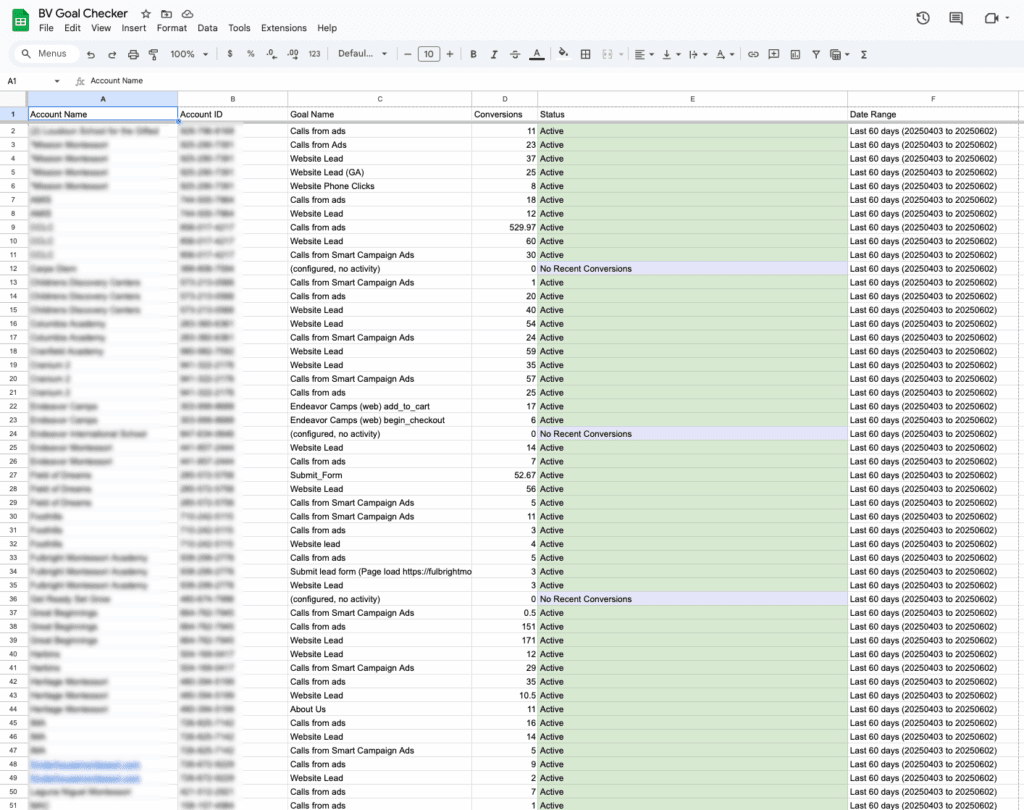
What This Script Does
This script audits every Google Ads account under your MCC and evaluates the status of each conversion goal over a defined lookback period. Instead of guessing which goals are active or broken, this system gives you a real-time snapshot in a Google Sheet and only alerts you when something needs your attention.
- Connects to your MCC and loops through each linked account
- Skips accounts you've blocklisted (excluded)
- Pulls campaign-level conversion performance over a set lookback period
- Evaluates the health of each conversion goal
- Log results in a Google Sheet, applying background colors to the status
- Emails a summary of only problematic accounts or goals
Email Notifications
There will be two email notifications: one for accounts needing attention and the other for all good accounts.
Example:
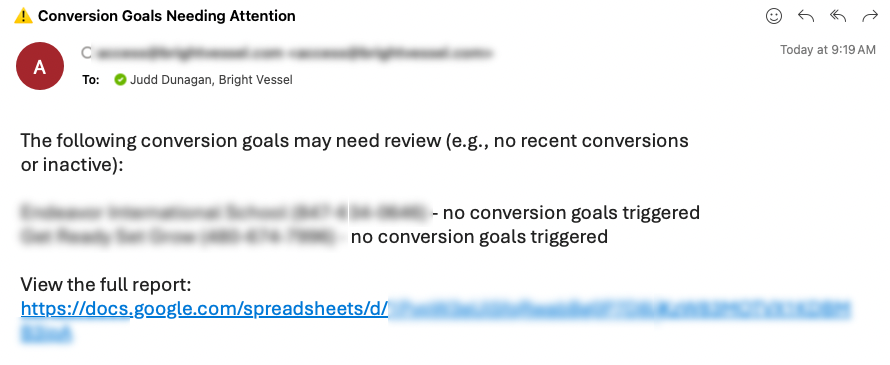
Messages:
Got it, your script needs two distinct email outputs:
-
✅ “All Good” Email (if no issues are found)
-
⚠️ “Needs Attention” Email (if any goals are inactive, missing, or low-performing)
Here’s precisely how both versions should look, using your sample data and current logic:
Message #1
All monitored conversion goals are reporting activity over the last 60 days.
No issues found in any accounts.
View the full report:
https://docs.google.com/spreadsheets/d/yoursheetid
Message #2
The following conversion goals may need review (e.g., no recent conversions or inactive):
Bright Widgets Inc (123-456-789) - Contact Form Submission (Needs Attention)
Acme Corp (987-654-321) - Schedule Call (Inactive)
Acme Corp (987-654-321) - Free Trial Signup (Needs Attention)
Rocket Leads (456-789-123) - (configured, no activity) (No Recent Conversions)
Beta Test Group (321-654-987) - (not set) (Inactive)
Zebra Analytics (999-111-222) - Whitepaper Download (Needs Attention)
View the full report:
https://docs.google.com/spreadsheets/d/yoursheetid
Requirements
Before deploying the script, make sure your environment is configured correctly. This script is designed to run within a Google Ads MCC context to write data and send alerts.
- Google Ads MCC account
- Google Spreadsheet (must be created manually)
The Original Script
This is the script in its complete, unedited form. All comments, formatting, and logic are exactly as originally written. Do not modify this if you plan to follow the breakdown later in this tutorial.
// ========== CONFIGURATION ========== const SHEET_ID = '1PvpW3eUl5fqRwabBg0P7D8LKzW83MOTVX1KDBMB3ipA'; const LOOKBACK_DAYS = 60; const EXCLUDED_ACCOUNT_IDS = [ '000-000-000', '000-000-000', '000-000-000' ]; const RECIPIENT_EMAILS = '[email protected]'; // =================================== function main() { const sheet = SpreadsheetApp.openById(SHEET_ID).getSheets()[0]; sheet.clear(); sheet.appendRow(['Account Name', 'Account ID', 'Goal Name', 'Conversions', 'Status', 'Date Range']); const startDate = getDateXDaysAgo(LOOKBACK_DAYS); const endDate = getTodayDate(); const dateRangeLabel = `Last ${LOOKBACK_DAYS} days (${startDate} to ${endDate})`; const accounts = MccApp.accounts().get(); const flagged = []; let rowIndex = 2; while (accounts.hasNext()) { const account = accounts.next(); const accountId = account.getCustomerId(); const accountName = account.getName(); Logger.log(`⏳ Checking account: ${accountName} (${accountId})`); if (EXCLUDED_ACCOUNT_IDS.includes(accountId)) { Logger.log(`🚫 Skipping excluded account: ${accountName} (${accountId})`); continue; } try { MccApp.select(account); const query = ` SELECT ConversionTypeName, Conversions FROM CAMPAIGN_PERFORMANCE_REPORT DURING ${startDate},${endDate} `; const report = AdsApp.report(query); const rows = report.rows(); const goalMap = {}; while (rows.hasNext()) { const row = rows.next(); const goalName = row['ConversionTypeName'] || '(not set)'; const conversions = parseFloat(row['Conversions']) || 0; if (!goalMap[goalName]) { goalMap[goalName] = 0; } goalMap[goalName] += conversions; } if (Object.keys(goalMap).length === 0) { Logger.log(`⚠️ No conversion data returned for account: ${accountName} (${accountId})`); const status = 'No Recent Conversions'; sheet.appendRow([ accountName, accountId, '(configured, no activity)', 0, status, dateRangeLabel ]); setStatusColumnColor(sheet, rowIndex, status); flagged.push(`${accountName} (${accountId}) - no conversion goals triggered`); rowIndex++; continue; } for (const [goalName, totalConversions] of Object.entries(goalMap)) { let status; if (totalConversions > 0) { status = 'Active'; } else if (goalName.toLowerCase().includes('test') || goalName === '(not set)') { status = 'Inactive'; } else { status = 'Needs Attention'; } sheet.appendRow([ accountName, accountId, goalName, totalConversions, status, dateRangeLabel ]); setStatusColumnColor(sheet, rowIndex, status); if (status !== 'Active') { flagged.push(`${accountName} (${accountId}) - ${goalName} (${status})`); } rowIndex++; } } catch (e) { Logger.log(`❌ Error processing account: ${accountName} (${accountId}) - ${e.message}`); } } if (flagged.length > 0) { const subject = '⚠️ Conversion Goals Needing Attention'; const body = `The following conversion goals may need review (e.g., no recent conversions or inactive):\n\n` + flagged.join('\n') + `\n\nView the full report:\nhttps://docs.google.com/spreadsheets/d/${SHEET_ID}`; MailApp.sendEmail(RECIPIENT_EMAILS, subject, body); } else { Logger.log('✅ All goals are reporting conversions.'); } } // 🎨 Apply color to only the "Status" column (Column E) function setStatusColumnColor(sheet, row, status) { const range = sheet.getRange(row, 5); // Column E switch (status) { case 'Active': range.setBackground('#d9ead3'); // Light green break; case 'Inactive': range.setBackground('#f4cccc'); // Light red break; case 'Needs Attention': range.setBackground('#fff2cc'); // Light yellow break; case 'No Recent Conversions': range.setBackground('#e6e6fa'); // Light purple break; default: range.setBackground(null); } } // 🕒 Helpers function getTodayDate() { const date = new Date(); return Utilities.formatDate(date, AdsApp.currentAccount().getTimeZone(), 'yyyyMMdd'); } function getDateXDaysAgo(days) { const date = new Date(); date.setDate(date.getDate() - days); return Utilities.formatDate(date, AdsApp.currentAccount().getTimeZone(), 'yyyyMMdd'); }
Script Breakdown by Section
CONFIGURATION
- SHEET_ID: Google Sheets destination for all output
- LOOKBACK_DAYS: Reporting window in days
- EXCLUDED_ACCOUNT_IDS: Client accounts to skip
- RECIPIENT_EMAILS: Who gets emailed when there's a problem
main() Function
- Opens the sheet, clears it, and sets up headers
- Calculates the date range
- Loops through every MCC sub-account
- Skips any that are blocklisted
- Uses CAMPAIGN_PERFORMANCE_REPORT to pull all goal data
- For each goal:
- Aggregates total conversions
- Assigns a status:
- Active: conversions > 0
- Inactive: test goal or not set
- Needs Attention: zero conversions, not a test
- No Recent Conversions: no goal data returned
- Appends data to the sheet
- Calls setStatusColumnColor() to mark each row
- Builds a flagged list and emails if any issue is found
setStatusColumnColor(sheet, row, status)
- Applies a background color to Column E depending on the goal status:
- Green for active
- Red for inactive
- Yellow for needs attention
- Purple for no activity
Date Helpers
- getTodayDate() returns today's date in the correct timezone
- getDateXDaysAgo() returns the date X days ago
This walkthrough shows how to set up the conversion goal health checker for your Google Ads MCC account. Follow each step to get the system running, write to Google Sheets, and send alerts when something breaks.
Step 1: Create the Google Sheet
Start by setting up the output destination.
- Go to Google Sheets
- Click "Blank" to create a new spreadsheet
- Please give it a name like Goal Monitor
- The part in the middle is your Sheet ID
- Paste the ID into your script where it says const SHEET_ID = '...'
Step 2: Open the Google Ads Scripts Panel
You will deploy this script inside your MCC account.
- Log in to your Google Ads MCC account
- Click "Tools and Settings" in the top navigation
- Under "Bulk Actions," select "Scripts."
- Click the plus (+) button to add a new script
- Paste the entire script exactly as written into the code editor
Step 3: Authorize the Script
The first time you use the script, you need to authorize it.
- Click "Authorize" in the upper right
- Select your Google account
- Approve all requested permissions
You must complete this step or the script will fail to run.
Step 4: Set Your Script Configuration
Inside the script, review and modify the following:
- SHEET_ID: Paste in your copied Sheet ID
- LOOKBACK_DAYS: Change if needed (default is 60)
- EXCLUDED_ACCOUNT_IDS: Add any accounts you do not want scanned
- RECIPIENT_EMAILS: Add the email or emails to receive alert reports
You can leave the rest of the script exactly as it is.
Step 5: Run a Manual Test
Run it once manually to make sure everything works.
- Click "Run" at the top of the navigation.
- Wait until execution completes.
- Open the connected Google Sheet.
- Check that:
- Headers were created
- Data was written for each active account.
- Statuses and colors are applied correctly in Column E.
Step 6: Schedule the Script (Optional)
To make this automatic, set it to run on a recurring schedule.
- From the script editor, click "Create Schedule."
- Choose a frequency (daily is recommended)
- Set the run time (early morning is ideal)
- Save and close
The script will run automatically and only alert you when something is off.
Step 7: Review Alerts
When the script runs, it checks all conversion goals. If any are inactive or not firing, you receive an email.
Summary
This script is not just a data dump. It's a watchdog for every conversion goal across your entire Google Ads MCC. You get alerted when something breaks, stalls, or quietly stops tracking. When everything is fine, you get silence.
It checks every account you manage, flags inactive or underperforming goals, and delivers a filtered, no-noise report straight to your inbox. The Google Sheet gives you a live view of goal status by account, goal name, and conversion volume, with visual cues baked in.
You’re not digging through interfaces. You’re not waiting until the end of the month to realize you’ve been blind. You’re in control before it becomes a problem.
Check out similar posts:
Check out similar posts:
If you manage multiple accounts, don’t miss our guide on tracking GA4 issues from numerous properties or exporting top-performing actual search terms with a lightweight script to refine your targeting.
Contact Us
Tired of guessing whether your tracking works? Want a team that builds systems instead of just reports?
Bright Vessel doesn’t just manage Google Ads; we engineer performance visibility at scale. Whether you need help deploying this script, integrating it into a larger automation stack, or building a custom analytics layer that tells you something, we’re ready.
Talk to the team that builds what other agencies fake.
The post How to Monitor Google Ads Goal Status Across MCC Accounts Using Google Sheets first appeared on B2B Website Platform Developer - Bright Vessel.
]]>The post How to Monitor GA4 Tracking Issues from Multiple Accounts with Google Sheets first appeared on B2B Website Platform Developer - Bright Vessel.
]]>The whole thing takes under an hour to set up and saves you from endless babysitting.
This guide will walk you through a step-by-step setup using Google Sheets and the SyncWith add-on to automatically detect and flag any tracking issues (like zero traffic) across multiple GA4 properties.
- SyncWith to pull traffic data into Google Sheets
- Google Apps Script to detect issues
- Automated email alerts to notify your team
Step 1: Pull GA4 Traffic Data into Google Sheets
Use SyncWith to pull your traffic data into a Google Sheet. It connects directly to GA4 and updates automatically.

How to set it up:
- Connect your Google Analytics account to SyncWith.
- Create a report grouped by:
- Date
- Property Name
- Add the metric: Total Users
- Filter the report to the last 3 days.
- Output the results to a sheet named something like 3 Day Report.
You’ll get a table that looks like this:
| Total Users | Property Display Name | Date |
|---|---|---|
| 52 | Website Property 1 G4 | 2025-06-02 |
| 0 | Website Property 2 G4 | 2025-06-05 |
| 218 | Website Property 3 G4 | 2025-06-05 |
Each row represents a day of traffic for a GA4 property.
Step 2: Use Google Apps Script to Check for Zero Traffic
Now that your sheet is automatically updated, we’ll write a script to scan for any property with zero users in the past 3 days. If any are found, it sends an email alert.
Status Email - All Good

Status Email - Oh no, but check some accounts.

Here’s the script:
function sendG4HealthCheckAlert() {
const SPREADSHEET_URL = 'https://docs.google.com/spreadsheets/d/Make_Sure_You_Use_Your_Sheets_ID/edit#gid=0';
const SHEET_NAME = '3 Day Report';
const EMAIL_TO = '[email protected], [email protected]';
const EMAIL_FROM = '[email protected]';
const EMAIL_SUBJECT = '⚠️ G4 Health Check';
const ss = SpreadsheetApp.openByUrl(SPREADSHEET_URL);
const sheet = ss.getSheetByName(SHEET_NAME);
const data = sheet.getRange(3, 1, sheet.getLastRow() - 2, 3).getValues();
const zeroAccounts = data
.filter(row => row[0] === 0)
.map(row => `• ${row[1]} - GA4 on ${row[2]}`);
let messageBody;
if (zeroAccounts.length > 0) {
messageBody = `
⚠️ G4 Health Check
One or more accounts have not recorded visits in the last 3 days:
${zeroAccounts.join('
')}
Open Dashboard
`;
} else {
messageBody = `
✅ G4 Health Check
All accounts are reporting data in the last 3 days.
Open Dashboard
`;
}
GmailApp.sendEmail(EMAIL_TO, EMAIL_SUBJECT, '', {
htmlBody: messageBody,
name: 'Bright Vessel Reports',
from: EMAIL_FROM
});
}
You can add or remove emails in EMAIL_TO. The script pulls data from the sheet, filters for rows where the user count is zero, and sends a clean alert listing the offending properties.
Step 3: Automate It with a Time-Based Trigger
To make this check run daily:
- In your Sheet, go to Extensions > Apps Script
- Paste the script above
- Click the clock icon on the left (Triggers)
- Set
sendG4HealthCheckAlertto run every day at a time of your choice
No manual checking. No forgotten data issues. If a property stops tracking, your team gets notified.
Standard Error: "400 Bad Request" When Opening Apps Script

If you try to open Apps Script and get hit with a 400 Bad Request error, it’s because Google doesn't play nice when you're logged into multiple accounts at once.
Fix:
- Sign out of all Google accounts
- Log in with only the one who owns the Sheet
- Or use an incognito window with a single account
This is a Google session issue, not your code or setup.
Final Thoughts
This setup is lean and fast. It does not use third-party dashboards or expensive tools. Instead, it uses data pulled via SyncWith and a simple script to ensure everything runs properly.
Check out similar posts:
If you're working with multiple GA4 properties, you might also want to streamline your paid search data. Learn how to export top-performing search terms with a Google Ads script or monitor goal status across your entire MCC in Google Sheets.
If a site flatlines, you’ll know within 24 hours, not three weeks later when a client starts yelling.
Work with the Experts at Bright Vessel
At Bright Vessel, we specialize in building innovative, scalable analytics systems for multi-location businesses, schools, and agencies. From Google Analytics 4 health monitoring to SEO performance alerts, we help our clients stay ahead of tracking failures and performance drops. Whether you're managing a handful of properties or hundreds, our team ensures your data flows seamlessly and your decision-making stays informed.
The post How to Monitor GA4 Tracking Issues from Multiple Accounts with Google Sheets first appeared on B2B Website Platform Developer - Bright Vessel.
]]>The post Using AI to Build Customer Journey Maps first appeared on B2B Website Platform Developer - Bright Vessel.
]]>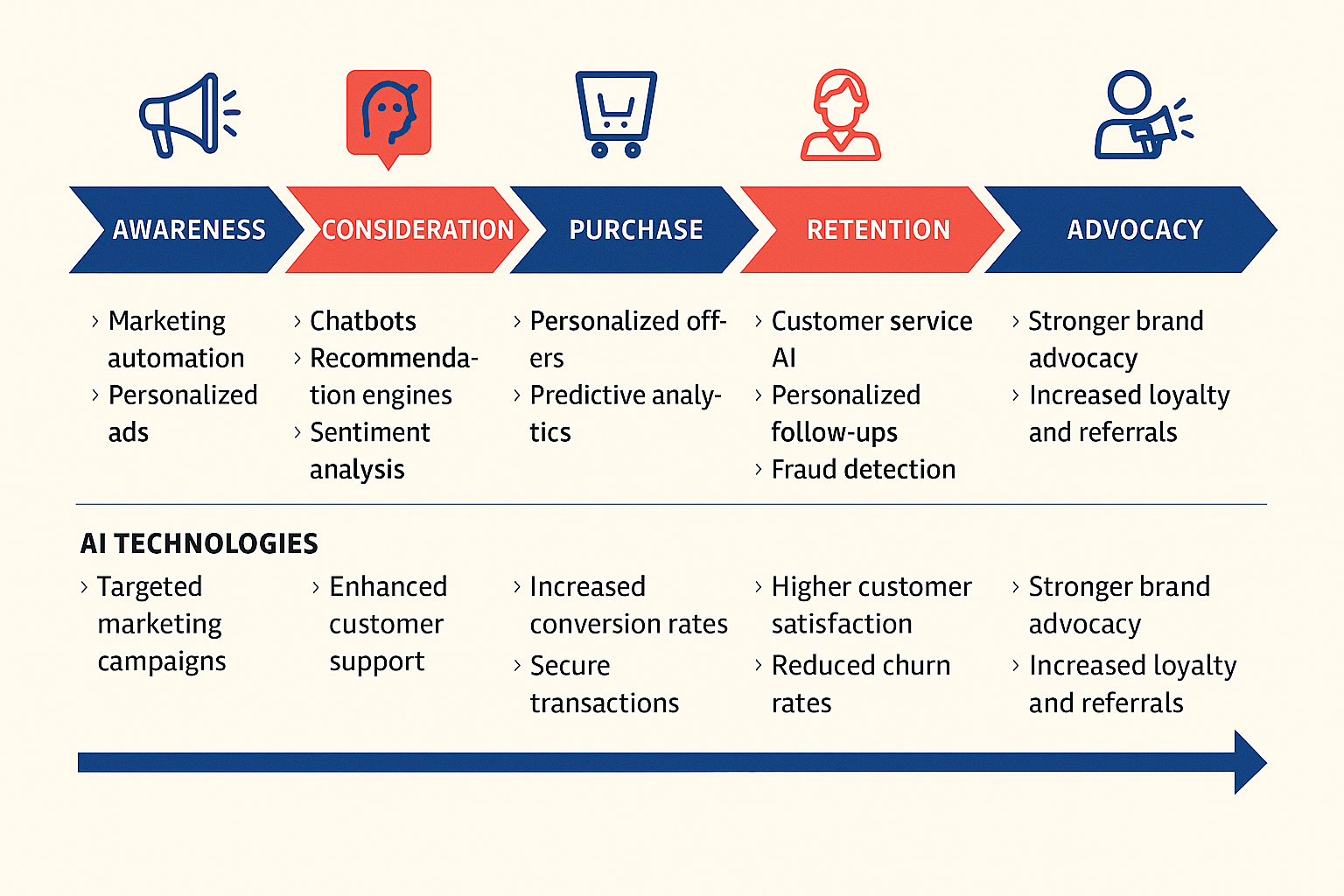
Why Use AI to Build Customer Journey Maps?
In today’s competitive digital landscape, understanding your customer’s journey is no longer a luxury; it’s a necessity. Traditional journey mapping methods often rely on assumptions, outdated data, or static diagrams that quickly become irrelevant. This is where artificial intelligence offers a transformative edge. AI doesn’t just digitize the process; it elevates it. By automatically analyzing customer behavior, interpreting feedback, and detecting trends, AI gives you an accurate, real-time view of how users interact with your brand.
Using AI removes much of the guesswork and bias from customer journey mapping. Rather than assuming what your customers are thinking or doing, AI uses real data collected from support transcripts, surveys, interviews, click paths, and more. The result? Smarter, faster, and more adaptive journey maps that evolve as your users do.
Key advantages of using AI in journey mapping:
- Automates the creation of customer journey stages and personas: AI tools can build journey stages from user data and develop personas from minimal prompts, saving time and improving accuracy.
- Extracts insights from large volumes of customer data and transcripts: AI can quickly identify patterns, pain points, and opportunities in support conversations and surveys.
- It saves time and reduces manual workload: AI-generated suggestions and visuals complete tasks that used to take weeks in hours.
- Supports better cross-functional collaboration: Teams across departments can stay aligned with real-time updates and AI summaries.
- Adapts maps to changing customer behavior: AI tools evolve journey maps based on the latest behavioral data.
In short, AI enables businesses to move from static, assumption-based journey maps to living, intelligent roadmaps that reflect real-world customer experiences.
Verified AI Tools for Customer Journey Mapping
Today’s leading customer journey mapping tools go far beyond basic flowcharts. Verified AI-powered platforms transform how teams map journeys by turning qualitative and quantitative customer data into actionable visualizations.

UXPressia - AI for Personas and Customer Journey Templates
UXPressia combines intuitive UX design with AI persona and journey map generation. Its AI assistant turns minimal input into detailed personas and suggests relevant journey stages.
AI Capabilities:
- Generates realistic personas from brief prompts or descriptions
- Recommends journey stages based on persona traits
- Improves persona relevance over time using input data
Summary:
- AI persona builder for early-stage research
- Interactive templates for faster mapping
- Ideal for visual and collaborative teams

Insight7 - AI That Converts Feedback into Journey Maps
Insight7 turns customer data into structured journey insights. Using AI, it processes transcripts, chat logs, and surveys to identify themes and pain points and map out journey stages.
AI Capabilities:
- Processes unstructured data like transcripts using NLP
- Detects feedback patterns and customer emotions
- Auto-generates maps that reflect actual user behavior
Summary:
- Ideal for research and customer success teams
- Reduces manual feedback analysis
- Delivers actionable insights from real data

Miro - AI Templates and Assisted Journey Mapping
Miro adds AI to its visual collaboration platform with innovative templates and idea generation. It helps teams structure and visualize user paths during workshops and planning.
AI Capabilities:
- AI-powered templates with structure suggestions
- Smart path generation for incomplete journeys
- Supports collaborative real-time editing
Summary:
- Best for fast-paced team collaboration
- AI suggestions help fill planning gaps
- Works as a co-pilot, not a complete automation tool

FigJam with AI Widgets - Whiteboard Meets GPT
FigJam, from Figma, integrates GPT-based plugins like Jambot to generate journey map content from simple text prompts. It is ideal for design sprints and ideation sessions.
AI Capabilities:
- Generates steps and interactions using GPT-4
- Customizable journey maps from simple prompts
- Integrates with design workflows
Summary:
- Blends freeform creativity with AI outputs
- Speeds up UX and design team workflows
- Works best with Figma design tools
How AI is Transforming Customer Journey Mapping
AI turns customer journey mapping into a dynamic, evolving process. It adapts journey stages automatically based on real-time behavior from surveys, interviews, and support tickets.
AI tools enhance insights by analyzing large volumes of qualitative and quantitative data. They detect behavior shifts and surface trends and suggest next steps to improve team decision-making.
What’s changing with AI:
- Real-time journey stages: Based on current behavior
- Dynamic personas: Updated automatically as user behavior shifts
- Pain point detection: AI recognizes friction using pattern recognition
- Data-based insights: Rooted in behavior, not assumptions
- Improved collaboration: Shared access to live, AI-powered maps
- Continuously evolving maps: Living dashboards over static diagrams
Choosing the Right Tool for AI Journey Mapping
Choosing the right tool depends on your needs.Insight7 is ideal for dealing with feedback or transcript data. To start from scratch, UXPressia offers guided persona and template creation.
Miro and FigJam are excellent choices for real-time collaboration and brainstorming. Miro enables rapid planning, while FigJam uses GPT-4 plugins to generate flows from natural language prompts.
| Use Case | Best Tool |
|---|---|
| Persona + journey templates | UXPressia |
| Feedback-to-journey mapping | Insight7 |
| Collaborative workshops | Miro |
| Visual AI ideation | FigJam + Jambot |
Final Thoughts on Using AI to Build Customer Journey Maps
AI takes customer journey mapping beyond visualization. AI enables action, not just observation, by detecting behavior patterns, revealing needs, and generating dynamic maps.
It also improves collaboration by providing real-time insights to all stakeholders. Whether you’re a marketer or a UX designer, these tools help you better understand and serve customers.
Ultimately, AI ensures your business actively learns from customers in real-time and adapts your strategies accordingly.
Are you looking to implement AI-powered customer journey mapping for your brand? Bright Vessel helps businesses build innovative digital experiences through data-driven strategy, advanced technology, and customer-centric design. Whether starting fresh or upgrading your journey mapping tools, our team can guide you with tailored solutions that align with your goals. Explore our services and discover how AI can transform your customer experience today.
The post Using AI to Build Customer Journey Maps first appeared on B2B Website Platform Developer - Bright Vessel.
]]>The post The Digital Marketing Landscape in 2024 first appeared on B2B Website Platform Developer - Bright Vessel.
]]>In the fast-paced world of digital marketing, staying ahead of trends is essential for businesses looking to maintain a competitive edge. As we delve into 2024, the digital marketing landscape has undergone significant transformations driven by technological advancements, evolving consumer behavior, and a heightened emphasis on inclusivity and sustainability. This article explores the current channels, emerging trends, and strategies businesses should adopt to thrive in this dynamic environment.
Current Digital Marketing Channels
1. Social Media Marketing
Social media platforms remain at the forefront of digital marketing strategies in 2024. Platforms like TikTok, Instagram, and YouTube are more influential than ever, especially among younger demographics. Here are some key trends and strategies:
 Short-Form Video Content: TikTok has popularized short-form videos, prompting businesses to create engaging, bite-sized content. Brands that effectively leverage this format see higher engagement rates and better audience retention.
Short-Form Video Content: TikTok has popularized short-form videos, prompting businesses to create engaging, bite-sized content. Brands that effectively leverage this format see higher engagement rates and better audience retention.
 Instagram Stories and Reels: Instagram remains a powerhouse for social media marketing, with Stories and Reels driving substantial engagement. Brands use Instagram Stories to share behind-the-scenes content, create interactive polls, and provide limited-time offers. Reels, on the other hand, are ideal for short, catchy videos that resonate with the platform’s younger audience.
Instagram Stories and Reels: Instagram remains a powerhouse for social media marketing, with Stories and Reels driving substantial engagement. Brands use Instagram Stories to share behind-the-scenes content, create interactive polls, and provide limited-time offers. Reels, on the other hand, are ideal for short, catchy videos that resonate with the platform’s younger audience.
 YouTube and Long-Form Content: YouTube is key for long-form video content in 2024. Brands use YouTube to share in-depth tutorials, customer testimonials, and behind-the-scenes footage. YouTube Shorts also allow businesses to reach a wider audience with shorter, digestible video content. The platform’s analytics tools provide valuable insights into audience behavior and preferences.
YouTube and Long-Form Content: YouTube is key for long-form video content in 2024. Brands use YouTube to share in-depth tutorials, customer testimonials, and behind-the-scenes footage. YouTube Shorts also allow businesses to reach a wider audience with shorter, digestible video content. The platform’s analytics tools provide valuable insights into audience behavior and preferences.
 LinkedIn Marketing: LinkedIn remains powerful for B2B marketing in 2024. Brands leverage LinkedIn to share thought leadership content, host virtual events, and run highly targeted ad campaigns. LinkedIn’s analytics tools help marketers improve their content strategy.
LinkedIn Marketing: LinkedIn remains powerful for B2B marketing in 2024. Brands leverage LinkedIn to share thought leadership content, host virtual events, and run highly targeted ad campaigns. LinkedIn’s analytics tools help marketers improve their content strategy.
 X.com and Real-Time Marketing: Formerly known as Twitter, X.com emphasizes real-time interaction and brand conversations. Businesses use X.com to engage with trending topics, handle customer inquiries, and run quick polls, boosting brand visibility and customer trust.
X.com and Real-Time Marketing: Formerly known as Twitter, X.com emphasizes real-time interaction and brand conversations. Businesses use X.com to engage with trending topics, handle customer inquiries, and run quick polls, boosting brand visibility and customer trust.
 Pinterest for Visual Inspiration: Pinterest is essential for brands aiming to attract audiences through visually appealing content. Brands create immersive pins with video and carousel formats to showcase products, provide tutorials, and encourage visits to their websites.
Pinterest for Visual Inspiration: Pinterest is essential for brands aiming to attract audiences through visually appealing content. Brands create immersive pins with video and carousel formats to showcase products, provide tutorials, and encourage visits to their websites.
 Facebook Advertising and Community Groups: Facebook remains a strong platform for advertising and community building. With detailed targeting options, Facebook Ads drive results for businesses. Brands also use Facebook Groups to build dedicated communities and engage with loyal customers.
Facebook Advertising and Community Groups: Facebook remains a strong platform for advertising and community building. With detailed targeting options, Facebook Ads drive results for businesses. Brands also use Facebook Groups to build dedicated communities and engage with loyal customers.
 Google Ads Integration with Social Campaigns: Brands integrate Google Ads with social media strategies to maximize reach. Cross-platform campaigns allow businesses to capture audiences at multiple touchpoints. Google focuses on seamless integration of ads across YouTube, Discover, and Search Network.
Google Ads Integration with Social Campaigns: Brands integrate Google Ads with social media strategies to maximize reach. Cross-platform campaigns allow businesses to capture audiences at multiple touchpoints. Google focuses on seamless integration of ads across YouTube, Discover, and Search Network.
 Podcast Marketing: Podcasts are popular as a storytelling medium. Brands sponsor podcasts or launch their own shows to delve deeper into industry insights, share customer stories, and promote new products. Audio advertising on platforms like Spotify and Apple Podcasts also provides targeted reach.
Podcast Marketing: Podcasts are popular as a storytelling medium. Brands sponsor podcasts or launch their own shows to delve deeper into industry insights, share customer stories, and promote new products. Audio advertising on platforms like Spotify and Apple Podcasts also provides targeted reach.
2. Email Marketing
Email marketing remains a cornerstone of digital marketing strategies, offering a direct line of communication with consumers. In 2024, effective email marketing focuses on:
- Personalization: Brands are using data analytics to segment their audiences and tailor email content to individual preferences, leading to higher open and conversion rates.
- Automation: Automated email campaigns allow businesses to send timely messages based on user behavior, such as cart abandonment reminders or personalized product recommendations.
- Interactive Elements: Incorporating interactive content, like surveys or embedded videos, can increase engagement and encourage recipients to take action directly from their emails.
- Mobile-First Design: With more users accessing emails on mobile devices, optimizing emails for smaller screens is crucial for readability and engagement.
3. Search Engine Optimization (SEO)
SEO remains a critical component of digital marketing in 2024. With search engines continually refining their algorithms, businesses must prioritize several strategies:
- Voice Search Optimization: As voice-activated devices become more prevalent, optimizing for voice search is essential. This involves focusing on natural language and long-tail keywords that align with how users verbally express their queries.
- Local SEO: Businesses with physical locations should optimize their online presence for local search results. This includes maintaining accurate Google My Business listings and gathering customer reviews to improve visibility.
- Quality Content Creation: High-quality, relevant content is still the backbone of effective SEO. Brands should focus on creating informative articles, blogs, and videos that address user queries and provide value.
- Visual and Video SEO: Optimizing visual and video content for search engines is crucial, with a focus on video descriptions, alt tags, and sitemaps.
4. Content Marketing
Content marketing continues to evolve, with brands recognizing the importance of storytelling and valuable information. Key aspects include:
- Diverse Content Formats: In addition to traditional blog posts, brands are leveraging various formats like podcasts, webinars, and infographics to cater to different audience preferences.
- User-Generated Content: Encouraging customers to share their experiences and content related to the brand fosters community and authenticity, which can be highly effective in building trust.
- Data-Driven Insights: Analyzing content performance through metrics like engagement rates and conversion can help brands refine their content strategies and focus on what resonates most with their audience.
- Interactive Storytelling: Leveraging new tools, brands are creating immersive experiences through interactive articles, 360-degree videos, and even augmented reality elements.
5. Paid Advertising
Paid advertising remains a crucial component of digital marketing, enabling businesses to reach targeted audiences effectively. In 2024, the focus is on:
- Programmatic Advertising: Automated ad buying using AI technology allows brands to optimize their ad spend and target specific demographics, ensuring ads are shown to the right users at the right time.
- Retargeting Campaigns: Retargeting ads serve as a reminder for users who have previously interacted with a brand. These campaigns can significantly improve conversion rates by keeping the brand top-of-mind.
- Social Media Ads: With social platforms offering advanced targeting options, businesses can create tailored ad campaigns that reach their ideal customers based on demographics, interests, and online behavior.
- Performance-Based Campaigns: Companies are increasingly adopting performance-based advertising strategies, where the focus is on measurable outcomes like conversions and ROI.
Emerging Trends in Digital Marketing
1. Artificial Intelligence and Machine Learning
AI and machine learning are revolutionizing digital marketing by enabling more personalized experiences. Key applications include:
- Predictive Analytics: AI can analyze consumer behavior patterns to predict future actions, allowing brands to tailor their marketing strategies accordingly.
- Chatbots and Virtual Assistants: Implementing AI-driven chatbots enhances customer service by providing instant responses to inquiries, thereby improving user experience and satisfaction.
- Content Generation: AI-powered tools are being used to generate marketing copy, product descriptions, and even video scripts, speeding up the content creation process.
2. Sustainability and Ethical Marketing
Today's consumers are increasingly concerned about social and environmental issues. Brands that prioritize sustainability and ethical marketing practices are gaining favor among consumers. Strategies include:
- Transparency: Brands that openly communicate their sustainability efforts and ethical sourcing practices build trust and loyalty with consumers.
- Cause Marketing: Collaborating with social causes and donating a portion of profits can resonate with consumers and foster a sense of community.
- Eco-Friendly Packaging and Operations: Brands that reduce their environmental footprint by adopting sustainable packaging and efficient processes can attract eco-conscious consumers.
3. Omnichannel Marketing
Providing a seamless experience across various channels is more crucial than ever. An effective omnichannel strategy includes:
- Integrated Messaging: Consistent messaging across all platforms—social media, email, website, and in-store—helps create a cohesive brand image.
- Cross-Channel Promotions: Encouraging customers to engage across multiple channels through promotions or loyalty programs enhances customer retention and satisfaction.
- Personalized Journeys: Using customer data to create personalized experiences across different touchpoints builds a stronger connection with the audience.
4. Video Marketing
Video marketing is experiencing explosive growth, with consumers favoring video content for information and entertainment. In 2024, brands should focus on:
- Live Streaming: Hosting live events or Q&A sessions on social media helps create real-time engagement with audiences.
- Short-Form Content: With platforms like TikTok and Instagram Reels gaining popularity, brands must create concise, impactful video content that captures attention quickly.
- Story-Driven Videos: Videos that narrate compelling brand stories can forge emotional connections with the audience, enhancing brand loyalty.
5. Enhanced Customer Experience (CX)
As competition intensifies, delivering exceptional customer experiences is critical. Key aspects of CX in 2024 include:
- Personalization: Tailoring experiences based on user preferences and behavior fosters deeper connections with customers.
- Feedback and Improvement: Actively seeking customer feedback through surveys or reviews allows brands to refine their offerings and address any pain points.
- Omnichannel Support: Providing consistent and responsive support across all customer touchpoints, such as live chat, email, and social media, enhances the overall customer experience.
Conclusion
As we navigate the digital marketing landscape in 2024, it is evident that adaptation and innovation are key to success. By leveraging emerging trends, optimizing existing channels, and focusing on delivering value to customers, businesses can thrive in a competitive environment. Staying informed and agile will be essential for brands looking to connect meaningfully with their audience and drive growth in the ever-evolving digital landscape.
The post The Digital Marketing Landscape in 2024 first appeared on B2B Website Platform Developer - Bright Vessel.
]]>The post 10 Tips for a Great LinkedIn Professional Profile first appeared on B2B Website Platform Developer - Bright Vessel.
]]>
Choose a Great Profile Picture
Your profile picture is one of the first things people will see when they visit your page, so make sure it's a good representation of who you are. LinkedIn recommends using a headshot cropped close to your shoulders and showing off your smiling face.
Your photo is the first impression profile visitors have of you. Keep it updated and realistic.
Ensure Your Headline is Interesting
Your headline is the second thing people will see on your LinkedIn professional profile, so it should grab people's attention and make them want to learn more about you. Make sure your headline is attractive and catches the reader's attention. Do not just use a job title on your headline. Create a clear, concise description that tells what you do or what you search.
Take a Skills Assessment
One way to show that you are a well-rounded professional is by taking a skills assessment. LinkedIn offers a variety of assessments that test your knowledge in different areas, such as marketing or sales.
Taking and passing a LinkedIn Skills Assessment is a great way to show off your skills and abilities. It will also help you connect with other professionals who have taken the same assessment. While displaying assessment skills is voluntary, it increases your chances of getting hired by at least 30%.
Add a Background Photo
A background photo is another way to make your LinkedIn professional profile stand out. LinkedIn allows you to upload a banner-like image that appears at the top of your profile. Adding a background photo is a great way to show your personality and make your profile more visually appealing. Just make sure that your background photo is appropriate and professional.
Get Endorsements and Recommendations
Endorsements and recommendations are two of the best ways to show potential employers or business partners that you are a reputable professional. LinkedIn allows you to add endorsements from other professionals for skills listed on your profile.
Recommendations are similar to endorsements, but they are longer and more detailed. You can ask for recommendations from colleagues, clients, or anyone familiar with your work. Reach out to professionals from whom you'd like to get endorsements and ask if they would be willing to write a recommendation for you. These are both great ways to show that you are a credible professional.
Join Relevant Groups
Joining relevant groups is a great way to connect with other professionals in your industry. LinkedIn has a variety of groups to join, and many of them are specific to certain industries or professions.
When you join a group, make sure to participate in the discussions and contribute value, as it will help you build relationships with other members and show that you are an expert in your field. Groups are a great way to connect with like-minded professionals and learn more about your industry. They can also be helpful when networking or searching for jobs.

Share Relevant Content From Your Feed
Your LinkedIn feed is full of content that could be relevant to your professional network. Share it on your profile when you see an article or post that you think would be interesting to your connections.
Sharing relevant content from your feed is a great way to show that you are knowledgeable about your industry and stay up-to-date on the latest news. It's also an excellent way to start discussions and engage with other professionals. Always share content that aligns with your point of view.
When you add comments to these discussions, be sure to add value and insights. This will make you stand out as an expert in your field. Well-expressed comments will also make you more memorable to the other professionals in the group.
Engaging with other users' content is a great way to start conversations and build relationships. It's also an excellent way to show that you are interested in what others say. When you engage with others, they are more likely to reciprocate and engage with what you're posting.
Turn Your Summary Into Your Story
Your summary is one of the most critical parts of your LinkedIn professional profile. This is where you have the opportunity to tell your story and explain who you are as a professional. Use your summary to highlight your unique experiences, skills, and accomplishments. You can also use it to share your career goals and what you're looking for in a new opportunity.
Make sure your summary is interesting, engaging, and tells a story that will make people want to connect with you. You could use help from friends and people you know to feel how your story sounds from a different perspective. Your summary is one of the best places to show off your personality and give potential employers or business partners a glimpse into who you are as a professional.
Grow Your Network
LinkedIn is all about networking. The more connections you have, the more opportunities you'll have to find a job or grow your business. You can start growing your network by connecting with people you already know, such as friends, family, or colleagues.
You can also connect with new people by joining relevant groups and participating in discussions. When you comment on someone's post or article, they'll get a notification that will prompt them to check out your profile. This is a great way to start building relationships with other professionals.
Another great way to grow your network is to attend LinkedIn events. These events are usually industry-specific and are a great way to meet other professionals in your field.
Update Your LinkedIn Professional Profile and List Relevant Skills
Your LinkedIn profile is like your online resume. You should update it regularly with your latest experience and accomplishments. You should also add any new skills that you've acquired.
Updating your profile will help you stay visible on LinkedIn and ensure that potential employers or business partners have the most up-to-date information about you. Adding relevant skills to your profile is also a great way to show off your expertise and attract new opportunities. The more relevant skills you add, the more meaning your summary and headline have, which helps you rank higher in LinkedIn search results.
Conclusion
Your LinkedIn profile is a valuable tool to help you find a job, attract new business opportunities, or grow your network. Use these tips to create a great LinkedIn profile that will positively impact everyone who sees it. Don't forget to regularly update your profile and skills so that your profile remains relevant and up-to-date. With a little effort, you can create a LinkedIn profile to help you achieve your professional goals.
If you want to stand out on LinkedIn, it's essential to have a well-written and engaging profile. At Bright Vessel, we understand how to craft a great profile that will get you noticed by the right people. Our expert writers can help you create a profile that accurately reflects your professional accomplishments and goals. Contact us today to learn more about our services.
The post 10 Tips for a Great LinkedIn Professional Profile first appeared on B2B Website Platform Developer - Bright Vessel.
]]>The post Email Marketing for Online Stores first appeared on B2B Website Platform Developer - Bright Vessel.
]]>What Are Your Goals?
Firstly, before embarking on the journey to crafting a great email marketing strategy, you need to define your goals. Determining your goals and objectives will enable you to set a definitive process from the onset.
Identify Your Target
Next, clearly define your target. Is it business to business or business to consumer? You need to determine the customers you intend to offer services to and whether they have the kind of problem your business can solve. Craft your email marketing to excite, attract and lure them into coming for your solutions or products.
The easiest way to determine who your target customers are is:
- Analyzing what your portfolio holds or who your existing clients are.
- Study who will benefit from your solution by doing online market research.
- Find out who your direct competitors' customers are.
After this, the next step is finding out and classifying your clients by determining common demographic details such as age, gender, location, income, and marital status.
Select Your Toolbox
A successful strategy will require you to use tools that will help you craft, disseminate, track and measure the marketing emails and campaigns.
For starters, you will need an email service provider. The email provider will enable you to create and send your emails and provide you with additional solutions for email tracking. Next, pick an automation tool that allows you to program and send emails at strategic times.
Once you've selected the tools needed to craft your strategic emails, write down the passwords you'll share with your team.

Qualify Your Leads
Qualifying leads involve reaching out to visitors by cold calling or using your ChatBots and customer service personnel to get them to trust you and share their email addresses. You can only do this through proven tactics to make customers want to hear more from you. A few tactics to get your customers' trust include:
Create Relevant Content on Your Website with a Request for Details
Top-notch content provides value to your prospective customers. You can choose to use educational, entertainment, or informational content that inspires them. Include a call to action requesting visitors sign up for more of your content or services.
Keep an Opt-In Form on Your Website's Service or Home Section
The opt-in button can be situated at the bottom of the page or sidebar for easy visibility while they browse your site.
Create Free Offers
One-time offers come in handy when requesting email addresses. You can offer free trials upon subscriptions or a freebie like an ebook.
Segment the Collected Email List
Email list segmentation involves demographically fragmenting your long list into smaller lists based on similarities. For example, one list can consist of ages between 30-35 or those in their thirties and forties. Don't forget to create a buyer persona for each list.
Create Customized Emails
Use the smaller lists you've created to customize your emails to reflect on your brand offerings and develop precise and on-target emails that will realize increased responses. Some tips to successfully customize your emails:
- Analyze your solutions and how they will address your clients' problems.
- Be consistent with the content on your website.
- Analyze whether your content ideas will work well in email messages.
Ready to email your potential customers? Make sure that your emails are personalized before hitting the send button. Tweak the customized emails to fit your customers' profiles and tastes before sending. Personalized marketing emails have a higher return on investment than generic emails.
How to Personalize Your Email Marketing
Personalized emails may consist of something as simple as a birthday card, which studies have shown to generate more than 300% return on investment.
To gather more personalized information, you can employ the use of digital marketing methods, such as:
- Use social media analytics and your website to get an idea of the products and services that generate the highest rate of engagement which plays a critical role in making them share more details.
- Design lead forms with additional fields that prompt your potential clients to feel in more detail on your website and social media sites. However, be cautious not to make your leads feel as if they are filling a loan application form by asking for more than is conventionally acceptable.
- Employ an email look-up tool to generate the leads' basic information such as server location, name, and social media profiles.
Use A/B Testing
Using A/B testing is critical to getting to know more about your customers. Test body copy, subject lines, layout, images, and many more, and change only one thing at a time to draw clear conclusions. This will help you determine the words that resonate better with your target market.

Set Up Trigger Emails
Trigger emails are sent out to your customers or potential customers while they're on your website. Trigger emails have proven to be more effective in generating replies because you reach out to the customers actively engaging with your content. You can set your triggered these emails to:
- Send a reminder immediately after a customer abandons their cart.
- Ask for feedback immediately after a customer completes a purchase or they've finished browsing your website.
- Send a welcoming email right after they navigate your website.
Share Your Values
Customers nowadays want to support brands they identify with and with missions that align with their core values. You can showcase the milestones of your corporate social responsibility initiatives, like how many orphanages you have supported or your company's impact on the environment, by participating in yearly tree planting events.
Use Dynamic Email Content
Using dynamic email content is the best way to personalize your email marketing. Your email content can be dynamic by including features like a countdown or a live feed from your blog or social channels.
Figure out How You Will Evaluate Your Marketing Campaigns
You have set your goals and gathered your marketing campaign creation tools. Then, you figured out your target market personas and demographics. Finally, you have qualified your leads, tested and personalized your marketing emails to achieve optimum results. Now it's time to establish how you will evaluate your marketing campaigns.
The best way to ensure this process is flawless is by creating email marketing strategy templates that will help you to keep tabs on the accurate net results. Alternatively, you can employ online tools like Hubspot to get an in-depth analysis and evaluation of what your efforts are yielding.
Conclusion
Creating an email marketing strategy is a process that involves a host of fine details that, if overlooked, will give you a hard time implementing and measuring progress and success. Employing a plausible marketing strategy template that you can tweak from time to time will greatly benefit your online store.
At Bright Vessel, we understand the importance of a spelled-out content plan. Contact us today for insights on content marketing strategy and how it can affect your bottom line.
The post Email Marketing for Online Stores first appeared on B2B Website Platform Developer - Bright Vessel.
]]>The post How to Increase Ecommerce Sales 2022 first appeared on B2B Website Platform Developer - Bright Vessel.
]]>
Know Your Customer
The essential thing in any online business or marketing is knowing exactly who your customer is. The internet gives us enormous power to target our advertising message to exactly the right demographic, which means more sales and less marketing spend.
You must know what that demographic is. So, if you haven’t already worked on creating customer personas that define who you sell to, start now. You could base this on your brick-and-mortar business’s customer profile, or you could start using social media, polls, and even surveys.

Create a Trustworthy Site
People like to shop online – but they like to buy from sites they can trust. They want to know who you are, where you are based, and if you are a legitimate company. Security signals like the little padlock that comes with your SSL certificate matter to online shoppers, and being able to contact you by email, phone, or even visiting a branch makes a difference too. Consider using WordPress for a fully customizable site that you can integrate with ecommerce platforms.
Make sure that your customers identify who your company is and that your site is clear and transparent.

Focus On the Funnel
If you’ve never heard of a sales funnel before, you need to research what they are and how they work. Here’s a basic overview of what the online shopping process looks like:
- A customer searches online for a particular product
- If your online advertising and SEO is good, they find your site and visit your page
- When they arrive on your site, they search for the product they want
- If they find the product, they review the price, availability, and shipping costs
- If they decide that you’re offering the best deal for the item, they place an order
- You deliver or ship the product to them
- If you do a good job of all these things, the customer might return next time they need a similar item
Your potential customer might not find what they need at any point along this process. In that case, they will go to the following website on their search results list, and you will lose the sale. You’ll also lose the opportunity for subsequent sales if they’re happy with the product and service.
So, you need to make sure that your website is optimized to deliver at every step of the process.

Your Products Aren’t Well Displayed.
Online shopping is a lot like shopping in person. Customers look for a price that they can afford or within their budget. Then they take a closer look at the product itself.
It’s essential to make sure that your products are well defined so that people have enough information to decide.
Make sure that your images are clear and that visitors to your site can zoom in to get a better look. Add multiple views to the product page, so people can turn it around the way they would in a store. If you can add a video of the item in use, that’s even better to give people a clear idea of the item they need.
Images are important, but the text content on your product pages matters too. Descriptions should be detailed and enticing. Include a variety of facts, specifications, and statistics. Sometimes, something as simple as the size, weight, or color of an item is enough to sway a customer, so make sure you add all that information on the product page.
Take a leaf from big online retailers’ books, too – by adding related items and upsells onto your product pages too. The longer you can keep your potential customer on your page and engaged, the higher the likelihood that they will buy from you.
Improve Your Payment Options
While it might not be expected, there are still customers who don’t have credit cards. This means if you only accept credit card payments, you might be losing sales.
Giving customers more than one option to pay for their purchases is a great way to increase e-commerce sales. Consider adding well-known and trusted third-party payment processors like PayPal, Stripe, or 2Checkout. Include an option to pay by credit card, and if you’re willing to process manual payments like checks, you can use that option as well.

Dial-In Your Shipping
Shipping is another huge factor for online sales. Many people say that shipping costs are the most significant factors in their online purchasing decisions.
If you can offer free shipping, that’s the gold standard for online shopping success. But if you can’t, try to provide more than one option. A slower, cheaper option might work for some customers, and faster courier services that cost a little more might appeal to others. If you are willing to offer pickup from your physical location, add that. Many people are shopping online for safety reasons these days, and if they can do a curbside collection, they might still choose to order from your online store for that reason.
Ship Promptly
People who shop online are not the most patient in the world. They expect you to ship their product within a reasonable time and receive it within as short a period as possible.
If you have longer shipping times, make sure that it’s clear on your website. Place a banner mentioning your shipping time on every page, so there are no nasty surprises after they’ve checked out.
Ensure that you send tracking information for shipments as soon as they are received. You’ll avoid a lot of angry follow-up emails if customers can log in to the carrier’s website and see where their order is.

Make Your Customer Feel Like the King (or Queen)
Customers online are not that different from the ones that visit brick-and-mortar locations. If your customer service is terrible, they will vote with their wallet and take their business elsewhere.
If you make them feel like royalty, answer questions, and solve problems promptly, however, they’re not only more likely to be repeat buyers, they’re also likely to recommend you to other people.
Perfect Your Marketing
Marketing an online store is a little different from a brick-and-mortar location. You can’t rely on foot traffic and location on the web! But there are a lot of other tools you can use to grow your presence and get more sales. Those include:
- Building an email list so you can email customers about specials, deals, coupons, and events
- Use paid ads on search engines to drive traffic to your website
- Use shopping comparison services like Google Shopping to get your store and your products in front of customers
- Creating social media profiles and engaging with potential customers about your products
- Using video services like YouTube to demonstrate how to use the products you sell
- Asking customers to review your products and your site online – reviews are a huge factor in online shopping decisions!

Offer Warranties and Return Options
People want to be reassured that they’re spending their money on a high-quality item that will fulfill their needs.
A warranty on your products is a good way to do that. So, if you offer a warranty on the items you sell, publish it on your website. Or, if you’re a reseller, make sure that you link to the manufacturer’s warranty or information on your page or theirs.
Returns are another big issue for online shoppers. If the item they bought doesn’t meet their expectations or arrives damaged or broken, who can they speak to, how do they send it back, and who pays for shipping.
Trust is even more important in online sales because shoppers can’t just bring an item back, so be upfront and honest about your policies, and then make sure you stick to them.
Pricing and Perks
Finally, when building or updating your online store, you need to consider pricing and perks.
Some online shoppers are completely price-driven, and they will always buy the cheapest product on offer. Others will consider other factors like your shipping policies, whether you’re a local business, or if you have social projects like supporting charities.
Many customers will also consider “perks” when they are shopping online. So, discounts on future purchases or free items with their order might sway them to choose your products, even if they aren’t the cheapest out there.
When customers are not entirely price-driven, the value you offer might very well be the deciding factor. So, make sure that every time your customers deal with you, they are delighted, and you underpromise and over-deliver.
The post How to Increase Ecommerce Sales 2022 first appeared on B2B Website Platform Developer - Bright Vessel.
]]>The post How To Improve Your WordPress Site's SEO first appeared on B2B Website Platform Developer - Bright Vessel.
]]>However, while it's true that search engines have changed their algorithms to focus more on quality and user experience, which doesn't mean search engine optimization is obsolete. In fact, in an ever more competitive online landscape, every little bit counts!
The lines between SEO, content and general site quality have blurred a little, but there are definite, concrete, on and off-site steps you can take to rank higher.
Get Good Quality Links
SEO used to be about getting as many links as possible. The more links you had, the more important search engines thought your site was. Those days are long over, and spammy links are a quick way to get your site penalized by search engines.
But that doesn't mean links should be completely ignored. Make sure your site is listed in relevant local directories and on services like Google My Business. A few links in industry publications don't hurt, nor do links from industry associations and organizations you belong to.
What you do need to avoid are spammy links in article comments or on completely irrelevant sites.

Use Internal Links
While lots of junky links to and from unrelated sites won't help you to gain credibility online, internal links can help a lot. Links tell search engine "spiders" when there's related content on your site, which helps them to catalog and classify your site and your content.
While we're on the topic of search engines and crawling, make sure you submit your XML sitemap to search engines and keep them up to date. Your sitemap tells search engines which pages are on your site, which helps to ensure that your pages get indexed. That, in turn, helps you to rank higher for your keywords and phrases.
Dial-In Your Keywords
Keywords for SEO have changed a lot too. Stuffing your site with keywords used to be a strategy, but with the shift to focus on quality content, that's not likely to win you any SEO prizes.
You should still do keyword research but stick to keywords that are closely related to what you do, and don't focus on things like keyword density too much. It's better to use variations of your keywords that look natural in your content than to try to shoehorn as many exact match words as you can in wherever you can.
Remember – your content should be written for humans first and search engines second!

Use SEO Tools
SEO tools help to ensure that your WordPress site is optimized and they're easy to use. If your site is built on WordPress, Yoast is one of the best and most trusted SEO plugins, and there's a free version, so you don't have to spend anything to use it.
Tools like Yoast also help to ensure that you are using keywords correctly. If you can, try to use relevant keywords and phrases in headings, subheadings, and links, because these will also help search engines to correctly index and catalog your site. The ultimate goal is to make sure that when someone searches online, your site comes up in the organic search results.
Content Really Is King
A very long time ago, internet marketing gurus declared content is king. Nothing has changed. In fact, as search engines and algorithms have changed to focus more on quality and the experience visitors have on websites, content has become even more important.
Quality content is the cornerstone of your SEO efforts. It's where you will be sending all that traffic you get, and there are some golden rules:
● Dive deep. Search engines have got very smart. They can tell when content is "thin" or low on useful information. So, try to make your content as detailed and in-depth as possible.
● When in doubt, opt for longer-form pieces. Content that is less than about 500 words is unlikely to rank well. So, write and create content that is long and detailed and really answers your reader's questions.
● Remember that content is all about your visitors. This is not a sales pitch. The content you post on your WordPress site should be valuable for the reader. So, make it interesting. Teach them something. Share your knowledge. It might not close the deal right away, but it will establish you as the go-to expert in your field.
● Break it up! Large blocks of content do not read well on screen. So, use links, headings and subheads, lists, bullets, and shorter paragraphs to keep it interesting and help people to read easier.
● Make sure you include images when relevant too, they make it a lot easier to understand and digest your content online.
● Update your content regularly. Search engines rank websites that have "fresh" content higher. You don't have to add new blog posts or content every day, but once or twice a week is ideal.
Use Metadata
The importance of metadata has decreased over time, but it's still an important way to tell search engines what your pages are about. It's also used as the description of your page in search results, so it matters to your visitors and readers too. Well-written metadata can help you to rank better and show up in more search results and entice people to find out more.
Keep Your WordPress Site Up to Date and Speedy
Over time, websites get slower. When things are out of date, or you have lots of unused widgets and plugins cluttering things up, your website won't load as quickly or smoothly.
Likewise, if your WordPress version and in-use plugins are out of date, they might slow things down or even produce errors on your WordPress site.
Make a habit of doing a little spring clean on your website from time to time. Remove old or unused items, make sure you don't have large files or images that aren't in use stored on your server, and update all your in-use widgets and plugins.
While you're at it, don't forget to audit and update your content from time to time. Some content is "evergreen," but some will need to be updated to reflect new ideas or technology.

Share and Automate
Even if you have the best information and content in the world, if no one knows it exists, it can't do its job!
Sharing content on social media and similar sites is a great way to promote your website and your content, and there's always the chance that it will "go viral." When your content is shared by other sites and people, those links to your WordPress site DO count towards your SEO, and they will influence your ranking!
There are lots of automation tools that can be built into a WordPress site to automatically post new content to your social media channels too, so you can save time and effort and still get the marketing boost!
Optimize Your Images
Images are very important to your WordPress site's usability, but they can slow things down, and if they are not optimized, they can count against you in SEO. There are a few ways you can optimize your images, such as:
● Use the smallest images possible. Larger images in high resolution take a long time to load, which won't hurt your SEO directly but can limit the time people spend on your site!
● Make sure all of your images are properly sized. Browser resizing is not good for SEO.
● Use alt text for all your images. If an image doesn't load for whatever reason, users will know what should have been there, and alt text for images can be indexed too – so it will count towards your SEO.
Always Use SSL
SSL used to be optional, but these days, it's very definitely on the list of things search engines consider when ranking your WordPress site. If your site doesn't have an SSL certificate or has a self-signed certificate, it won't rank as high as it might otherwise.
Make It Mobile Friendly
Another big change in SEO and search engine rankings was what is known as "Mobilegeddon," which was a giant search engine algorithm update that happened a few years ago. Sites that weren't mobile-friendly were automatically downgraded, and any new sites that weren't mobile-friendly automatically ranked lower.
A mobile-friendly site is often as easy as using a responsive template, so if you aren't already, start now!
Create a Checklist
A big part of good SEO is consistency, and the best way to do that is to make a checklist. Make sure that your articles, images, and content are correctly formatted from the start. Add metadata when you upload new content. Schedule regular cleanups and stay on top of everything.
It is possible to fix bad SEO, but it's a lot easier to do it right from the start. So, whether you do it yourself or outsource your SEO, make sure your WordPres site checks all the right boxes all the time.
The post How To Improve Your WordPress Site's SEO first appeared on B2B Website Platform Developer - Bright Vessel.
]]>